Wherein Isildur Pockets the One Ring, the Kingdoms of Men Fall Apart, Wizards Show Up, the Dark Lord Rises Again, and a Halfling Goes On a Big Journey
The second half of The Silmarillion’s final chapter isn’t the end of all things. It’s just the end of this one book, a wrap-up to one of the finest in fantasy literature. Even Tolkien’s most casual readers will find many parts of this section familiar, what with all the sly winks, cameos, and name-dropping. But it’s more than just a massive spoiler about what happens with Sauron’s favorite piece of jewelry: “Of the Rings of Power and the Third Age” overtakes the events of the War of the Ring and brings the story of the Elves to a close. After all, the end of this age also means it’s time “for the dominion of Men and the decline of all other ‘speaking peoples’ in Middle-earth.”
More than ever, I’m going to tie in information from Appendix A of The Lord of the Rings, so as to arrange events in a clearer chronology than the chapter alone gives us. Likewise, The Silmarillion’s sidekick, Unfinished Tales, will chime in to fill in some gaps.
Buckle up, this is a big one. The Primer Installment to End Them All.
Dramatis personæ of note:
- Isildur – Man, Ringbearer, arrow-catcher
- Elrond – Half-elf, loremaster, prospective father-in-law
- Galadriel – Noldo, lady of the Golden Wood, looking glass fortune-teller
- Círdan – Teler, Shipwright, lord of the Grey Havens
- Gandalf the Grey – Maia, Istar, secret agent of the even more Secret Fire
- Saruman the White – Maia, Istar, wizard of nefarious and multifarious colours
- Witch-King – Nazgûl, Morgul-lord, bully
- Eärnur- Man, “last” king of Gondor
- Aragorn – Man, Ranger, returning king
- Frodo – Halfling, Ringbearer
- Sauron – Maia, Necromancer, shadow of malice, shithead
…and The Third Age
It’s now year 1 of the Third Age and the aftermath of the Battle of Dagorlad, where the Last Alliance of Elves and Men had finally thrown down the new Dark Lord—and the forces of darkness were driven forever from the face of Middle-earth. (Kidding.) But at least with the head of the great Mordor snake cut off, the body is useless (mostly); Sauron’s forces are scattershot. His soldiers run off in all directions, but many do live on to trouble Middle-earth, if no longer united under the banner of their Dark Lord. Some Men who fought for Sauron turn away from their evil past and now submit to Isildur, who is the only noteworthy king of Men. Still others grumble and just turn away, hating the Dúnedain and biding their time, waiting for revenge.
Meanwhile, the siege is completed, and the Last Alliance makes sure the fortress of Barad-dûr itself is thrown down (not counting the mezzanine)—though, and this is important, its foundations are not removed. This might be seen as an oversight, but given that the Dark Tower was made strong by the One Ring’s own power, it might be that the Last Alliance simply cannot remove them. The Númenóreans and the Elves might be the most “technologically” advanced people on the continent, but I don’t think demolition is their strong suit.
In any case, Isildur’s got the One Ring now. And right there on the plain of Gorgoroth, Elrond and Círdan advise him to march it on up into the Cracks of Doom and just toss it in. Unmake it now to ensure that the very inhuman spirit of Sauron remains “diminished” forever. But why should he? He, Isildur, had dealt Sauron the blow that vanquished him, and surely he gets the lion’s share of the XP! With the boss monster defeated, its treasure goes to the victor. Isildur calls the Ring his “weregild,” or restitution, for the loss of his father and brother.
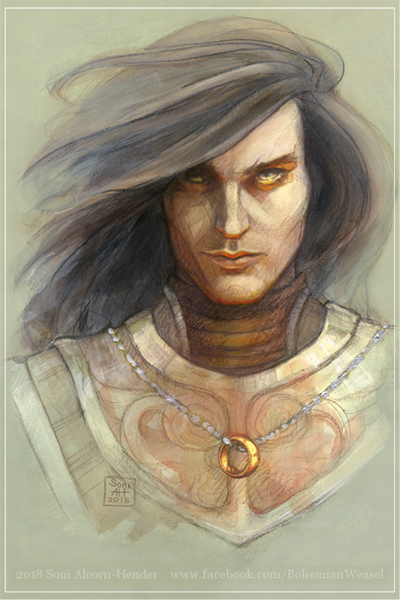
Now, Isildur’s not some evil jerk whose overmastering pride aims to wield the One Ring. He’s the same guy who nearly died just to cut a piece of fruit from the White Tree in Númenor, and he’s done many valorous deeds since. That said, the Ring makes itself precious to him, and “exceedingly fair to look upon,” just as it does to almost everyone who beholds it, and this outweighs the good counsel of two very wise Elves.
Seriously, Elrond is the son of Eärendil the Mariner who circles the world in a blessed spaceship with a Silmaril on his head, and he’s also the brother of the first king of Númenor, from which Isildur is many generations descended. And Círdan? Forget it. The dude was part of the great march of Eldar before the Sun and Moon were even things, and he’s met Maiar and Valar face to face on the western shores of Middle-earth. Oh, and by the way, he also helped to build the aforementioned spaceship. Goddamnit. But yeah, what do they know?
It’s symbolic, maybe, that Isildur’s rejection of this very good advice is kind of where the long estrangement between Men and Elves really begins. With both Elendil and Gil-galad gone (the co-founders of the Last Alliance), things just sort of drift apart. The kingdoms of Men will soon fragment into petty realms, while the already reduced number of Elves withdraw into smaller, secretive resorts.
But first, there is other business to attend to. Isildur takes the Ring with him to Minas Anor, that tower on the west side of Osgiliath, where his late brother used to live. There, just two years into the Third Age, he plants the White Tree’s sapling in its court. Here also he leaves his nephew in charge of Gondor, as Isildur himself is now intent on taking his father’s place as the king of Arnor up north.
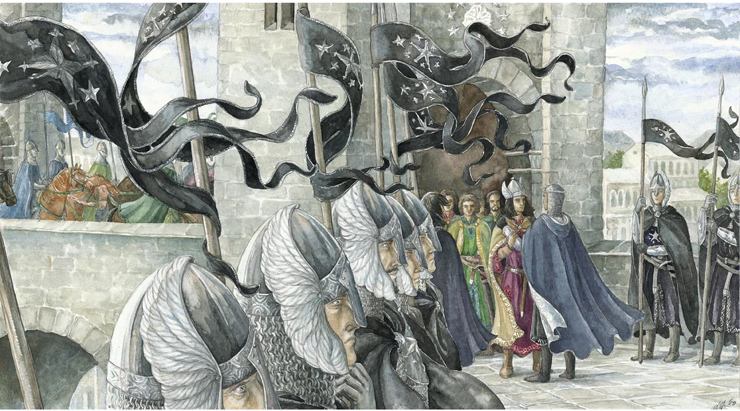
So he heads not northwest—which would be direct passage through the plains that will one day be called Rohan—but rather by the same route his father took in the Last Alliance. His intent is to cross the Misty Mountains further up and pass through Rivendell on his way to Arnor.
It doesn’t go so well.
In brief, the character and precise fate of Isildur is made clearer in “The Disaster of the Gladden Fields” section of Unfinished Tales, where we’re told that he desires to go to Rivendell not merely to pass through and collect his wife and youngest child (where he left them to go to war), but to seek the counsel of Elrond. That’s right, he’s finally ready to take advice from one of the Wise. Why? Because the One Ring has already become a burden to him, though he’s had it for less than two years. And he knows that it should be given to the keepers of the Three Rings.
And so it is near the Gladden Fields, that marshland between the River Anduin and the Misty Mountains, where Isildur’s entourage is attacked by a large band of Orcs. Orcs not under the command of any real leader, but feasibly drawn to the One Ring.
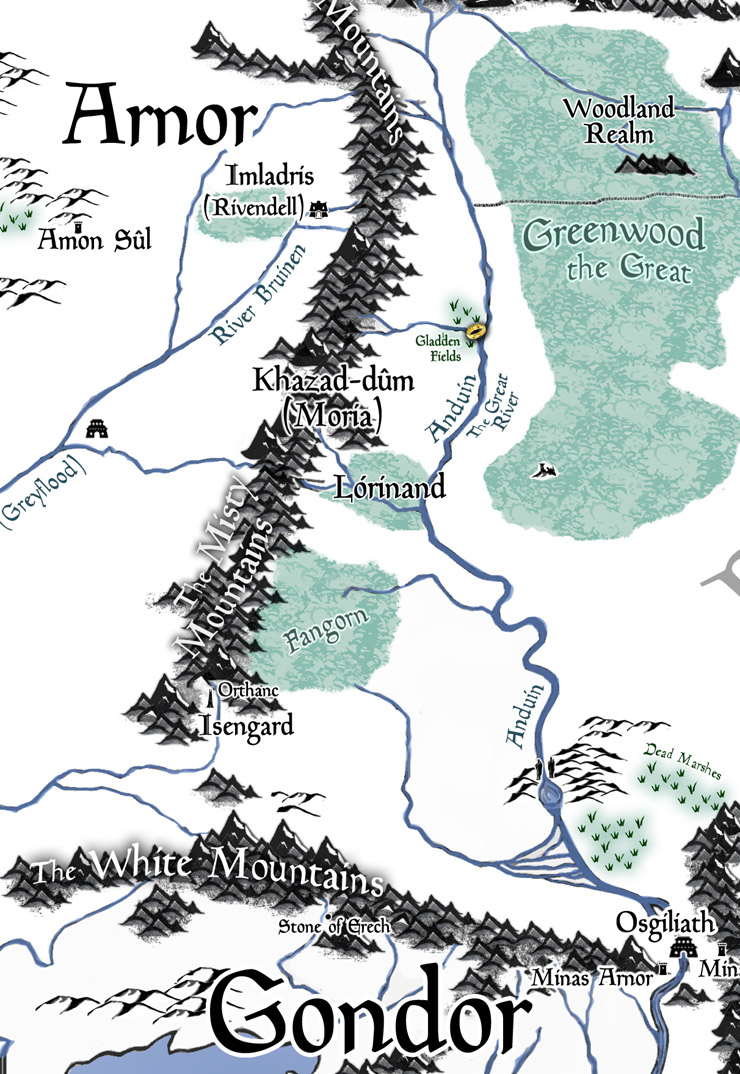
With his own band vastly outnumbered, and only at the insistence of his own sons, Isildur puts on the One Ring and escapes, invisible, retreating to the River. He doesn’t even want to (‘I dread the pain of touching it.’), but his eldest son demands it:
Go! Take your burden, and at all costs bring it to the Keepers: even at the cost of abandoning your men and me!
In pain, Isildur slips it on, and for thousands of years no one knows what happens to him and the One Ring to Rule Them All. But we know that Orcs stalk him like game, the Ring eventually quits him, and while he struggles “amid great rushes and clinging weeds” of the marsh, his hunters see his figure at last in the dark of night. He is struck in the throat and heart by arrows.
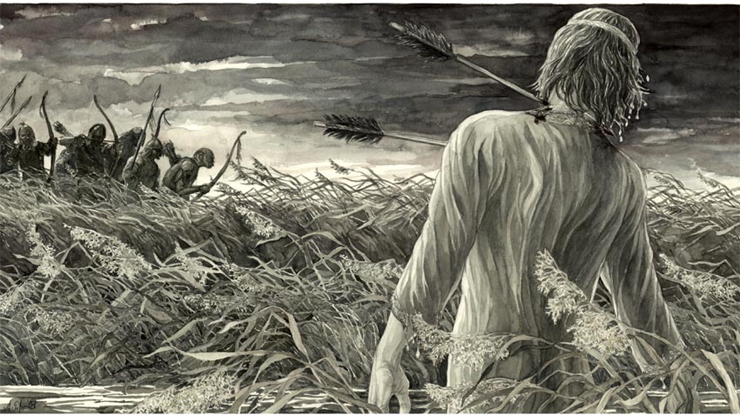
Isildur’s unarmored body drifts away in the water. He gets no grave, no tomb, nor are any of his kingly trappings recovered anytime soon.

Especially not the One Ring, which vanishes into the Anduin, and it’s not like anyone even knows that that’s the place to start searching for it. Meanwhile, only three guys from Isildur’s escort survive that Orc ambush. One of them does have the shards of Narsil in his possession, though, so they’re then kept safe in Rivendell—maybe, just maybe, to be used by the hands of some heir of Isildur’s.
“We’ll see,” Elrond basically says about that. “I mean, only if the One Ring is found again will that even be necessary.”
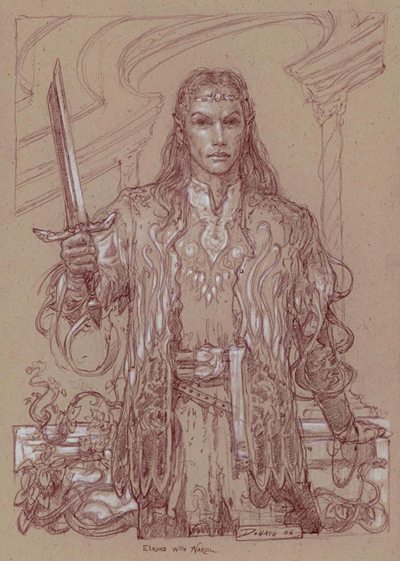
The first such heir is Isildur’s only surviving son, Valandil, who grows up and moves into the capital city of Arnor as its now-third king. But as the years roll on, Arnor declines (as all things do in Middle-earth). It simply doesn’t have the numbers or the influence it once had to maintain all the cities, watchtowers, and other marvelous constructs across its great expanse. Then there’s the general thinning out of Númenórean blood as the Dúnedain mix and match with the not-as-gifted-or-long-lived Men of Middle-earth. So by the death of Arnor’s tenth king, it fractures into three separate smaller kingdoms: Arthedain, Cardolan, Rhudaur. Each one of them is ruled by one of that king’s squabbling sons.
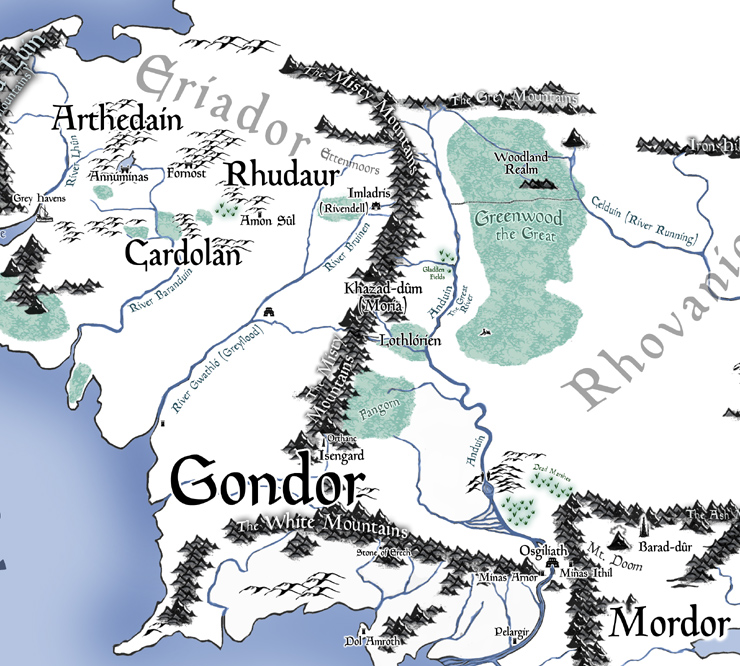
Gondor fares much better than these northern kingdoms and even flourishes and grows stronger again for quite a while, starting with the reign of Isildur’s nephew and running for more than thirty more kings before the royal line stops short. We’ll come back to that. Meanwhile, that seedling that Isildur planted anew in the court of Minas Anor actually gets to grow and last a good long while.

For 1,634 years, in fact! But it will eventually wither—coinciding with a terrible plague that sweeps through the land. Fortunately, another seedling will be planted. But then that one will die, too…1,232 years later! And then that’s it, no more seedlings. Bummer.
Okay, but what about the Elves? Well, as the centuries go by, the old friendships—even basic relations—between the kings of Men and the Elves fades. There aren’t all that many Elves left, for one, and they continue to live on in smaller enclaves and havens, ageless and immortal. Whereas the lives of Men are short, fleeting, and the lives even of the Dúnedain gradually shorten. The Firstborn and Secondborn Children of Ilúvatar become estranged, and the stranger something is, the more it is feared.
Since Sauron has been vanquished and his Ring mislaid, the keepers of the Three Rings are actually able to use them safely. So they dig them out of hidey-holes, fish them out from between couch cushions, or wherever the Wise tend to stash Rings of Power. They are finally able put them back on again, to use the Three as Celebrimbor intended! Thus their extraordinary powers of preservation strengthen the presence of the Elves in the Third Age, based on where they’re used and by whom. Without the Three Rings, which Celebrimbor chanced to make, the Elves would surely have a much smaller role to play in the War of the Ring (which at this time is still very far off).
I mean, if chance it was.
Rivendell is pretty much Elf-central now, a “refuge for the weary and the oppressed” on Middle-earth, the Last Homely House where friendly fires burn and both the memory and literal relics of the past are preserved by Elrond. Here, the Dúnedain and especially the heirs of Isildur have a place to crash. Here there is wisdom and healing in abundance. Vilya, the blue Ring of Sapphire and the mightiest of the Three Rings, helps Elrond’s estate to be its best self.
It’s like a Canadian once sang:
You feel there’s something calling you
You’re wanting to return
To where the Misty Mountains rise and friendly fires burn
A place you can escape the world
Where the Dark Lord cannot go
Peace of mind and sanctuary by Loudwater’s flow

Oh, and Elrond gets hitched! He’s met a lovely Elfmaid, Celebrían, who just happens to be Galadriel’s daughter (making her mostly Sindarin but with some Noldorin and Vanyarin blood). After a nice twenty-one-year honeymoon—no doubt right there in Rivendell, holding down the fort—Celebrían gives birth to twin sons. Elrond and Celebrían take an eleventy-one-year break, then have a third child: one Arwen Undómiel, who bears an uncanny resemblance to her ancestress, Lúthien.
Meanwhile, on the west end of Eriador, Círdan holds down his own fort as the master of the Grey Havens. Not only does he still oversee Middle-earth’s Elven emigrants, he’s the keeper of Narya, the Red Ring—but only for a little while (just the first thousand years of the Third Age). Being the world’s preeminent shipwright, Círdan’s not exactly the ideal candidate to bear the Ring of Spiritually or Literally Setting Things On Fire. So he doesn’t use it. He bides his time, protecting Lindon, with eyes often looking West.
On the east side of the Misty Mountains there are two notable Elf-lands, and they’re even more aloof from mortal lands. In the forest of Greenwood there is the Woodland Realm, where Thranduil rules as king of the Wood-elves. His people, at least, will eventually have some commerce with Men (Dale and Laketown), but for the most part they’re an insular bunch. Only Unfinished Tales tells us that Thranduil’s own dad had fought and died in the Battle of Dagorlad, there among the Dead Marshes.
Lastly, there is Lórinand, which joined in the wars against Sauron in the Second Age, but when its weary king departs for Valinor in the Third, Galadriel and Celeborn are left in charge—the former no doubt stoked to have a place of her own to rule. And so this is the forest-realm that becomes Lothlórien; Galadriel alone would have been familiar with the original Lórien in Valinor, home of the married Valar of dreams and quietude, and which inspired this, its Middle-earthen reflection in name and spirit.
From Gil-galad (who in turn received them from his Númenor friends of old) she received the seeds to plant those giant mallorn trees we read about in The Lord of the Rings. The mallorns that give the Golden Wood its signature look. They grow nowhere else on Middle-earth, and probably only due to Galadriel’s own power—enhanced greatly by Nenya, the white Ring of Adamant. With her watery Ring of Power, she preserves the beauty of Elvendom in Lothlórien, cooks up the scrying power of her namesake Mirror, and I guess keeping the drinking fountains running cool and refreshing?
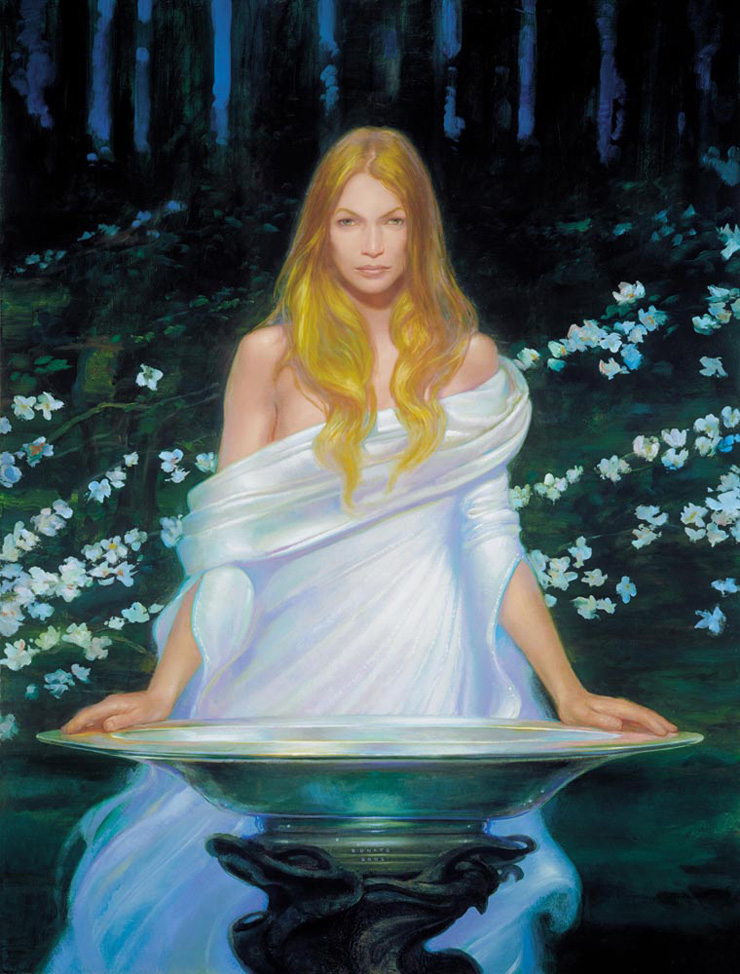
Just about a thousand years into the Third Age, when Gondor is still strong but Arnor has already fractured, some mysterious boats arrive at the Grey Havens. In them are some bearded, staff-wielding senior citizens who look a lot like Men but sure aren’t. These are, of course, the Istari, the color-coded wizards of Tolkien’s legendarium, and arguably the most dynamic geezers on Middle-earth. Well, two of them, at least.
Very few individuals will ever know who these guys really are, but Círdan is there to welcome them. He knows what’s up—or will, soon enough. The Istari are Valar-chosen Maiar sent to Middle-earth with a clear objective (contest the power of Sauron) but under some restrictions on how to achieve it (namely, in a low-key fashion). The first wizard to arrive is Curunír, a.k.a. Saruman, a Maia of Aulë, who actually volunteered for the task. He wanted to come. We’re also told he is the oldest of the Istari, which means Ilúvatar must have thought him up in the Timeless Halls before the others, if that makes any sense. Then comes Radagast, a Maia of Yavanna, along with two others not named in The Silmarillion (but they’re Alatar and Pallando). Tagging along as the fifth is a Maia we were expressly introduced to back in the Valaquenta: Olórin, a.k.a. Gandalf, Mithrandir, the Grey Pilgrim. Stormcrow!
Círdan quickly pegs the importance of this last one; he’s an excellent judge of character. And not only does he know that these gentlemen are Maiar on a mission, he has the wisdom and foresight to know that Mithrandir is the right man for the job of bearing the Ring of Fire. So Círdan gives it to him…
for thy labours and thy cares will be heavy, but in all it will support thee and defend thee from weariness. For this is the Ring of Fire, and herewith, maybe, thou shalt rekindle hearts to the valour of old in a world that grows chill.
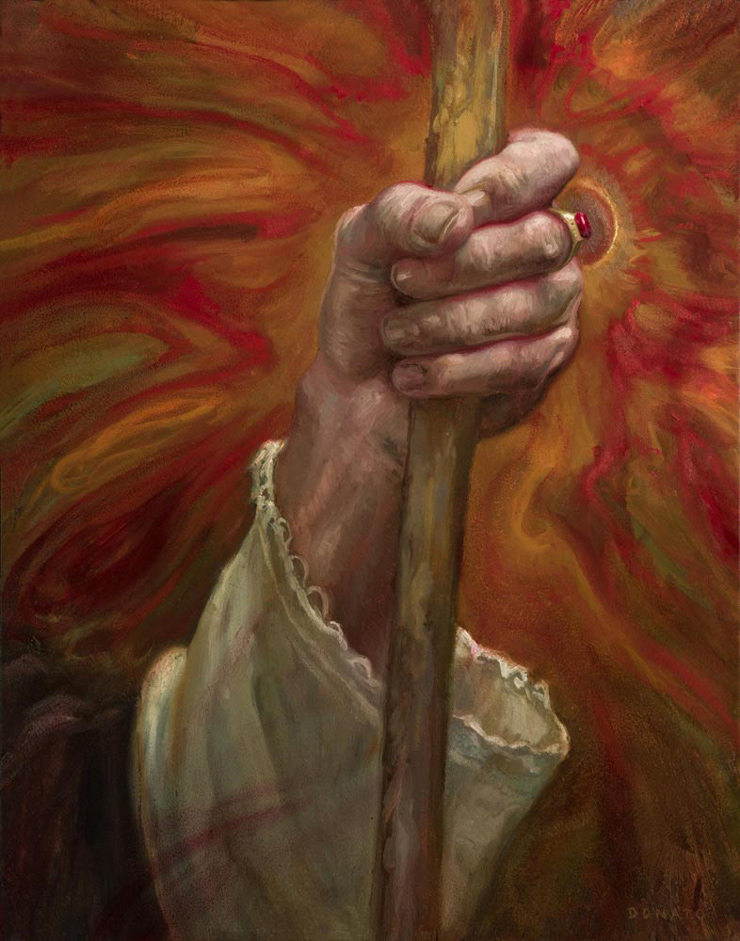
The wonderful Istari section in Unfinished Tales is one of the few places where it’s made quite clear that the Valar know they made some missteps in the handling of the Elves way back when. Here is the specific wording, and it’s presented in one windy but informative sentence that also gives us a clear mission statement for the wizards:
And this the Valar did, desiring to amend the errors of old, especially that they had attempted to guard and seclude the Eldar by their own might and glory fully revealed; whereas now their emissaries were forbidden to reveal themselves in forms of majesty, or to seek to rule the wills of Men or Elves by open display of power, but coming in shapes weak and humble were bidden to advise and persuade Men and Elves to good, and to seek to unite in love and understanding all those whom Sauron, should he come again, would endeavor to dominate and corrupt.
The Istari have not only been picked by the Valar, the whole operation has got the Ilúvatar stamp of approval. Five wise and divinely-fueled wizards (in one Unfinished Tales passage, it’s suggested there might even have been more than five) is surely enough to contend with Sauron, who is himself a Maia. But as we’ve seen before, not all Maia are equal in power.
Fascinatingly, also from Unfinished Tales, we learn that Olórin is reluctant to go at all. He feels he’s too weak; moreover he fears Sauron. Which makes Manwë want him for the job all the more. It’s almost like above all, Gandalf is the most motivated to succeed, and will take the task all the more seriously. Given that he ends up being the only wizard (or nearly so) to carry out the mission, it sure is good Manwë chose him.
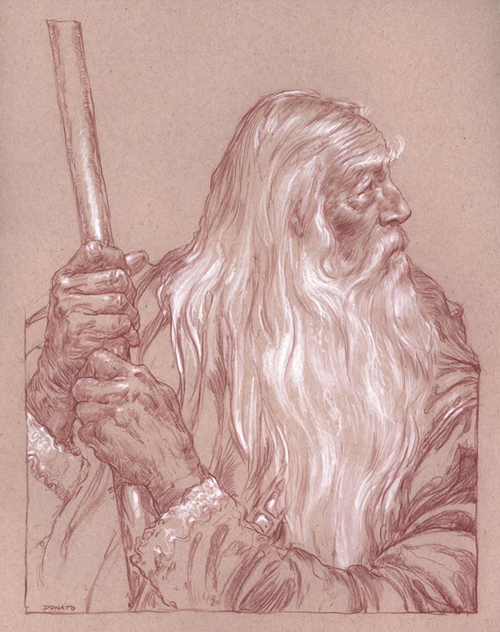
Not long after the arrival of the Istari, Men in and around Greenwood the Great start calling this forest by a new name, on account of it getting darker and scarier. Now it’s Mirkwood, everyone: buy new maps!
Buy the Book
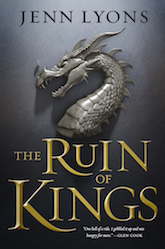

The Ruin of Kings
And right around the same time, Eriador is blessed by some rather diminutive immigrants padding quietly over the Misty Mountains from the northern regions of the Anduin. They’re shorter than Dwarves but way fonder of eating. These are the Periannath (which is Sindarin for “Halflings”), and they’re most likely a heretofore unknown branch of Mankind. But that in itself shouldn’t be a surprise. Flying under the radar, and staying out of the considerations of the great and wise (well, most of them) is kind of what halflings do. Anyway, they migrate westward, group by group, until they eventually settle into the idyllic and fertile hills of Arthedain (one of those three squabbling kingdoms that were formerly a part of Arnor).
So yeah, Hobbits are now on the scene. Everyone can relax. They got this.
Well, all right…not just yet. It’s the Istari who are here to help…and then they promptly go their separate ways. The two blue wizards disappear in the East, leaving us to wonder if they ever do anything at all; or maybe their work keeps Sauron’s flunkies in the East from doing even greater harm than they’d intended. Radagast the Brown is futzing around with nature and generally being idle. This leaves Saruman the White and Gandalf the Grey to deal with the whole contest-Sauron thing. Saruman also ventures out East but eventually circles back and falls into the study of the Rings of Power. Unsurprisingly, as a fellow Maia of Aulë, he’s into the devices and methodologies of the Enemy.
Gandalf, meanwhile, just does what Gandalf does best. He rambles on, “a stone doomed to rolling,” always listening and watching. He definitely puts to good use the pity and patience he’d learned in the house of Nienna back in the Valaquenta. And maybe with his shiny new Ring of Fire he’s rekindling some hearts—maybe even tossing the odd pinecone-fireball at a warg now and again? And let’s not forget the mysterious Tom Bombadil, with whom Gandalf seems to be acquainted. I bet he stops in and has some chats with him from time to time. Tom may be a “moss-gatherer,” but he’s been around a helluva long time and knows a thing or two about what’s natural and what’s not in Middle-earth.
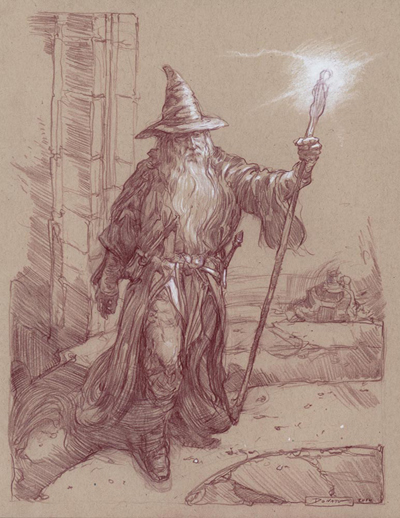
And so it’s Gandalf who first gets a bee in his bonnet about Dol Guldur, an old hill-fortress that used to be the Wood-elves’ capital, but is now long abandoned. It seems an evil something has taken up residence there, and it’s clearly responsible for mirking up the all woods of the forest formerly known as the Greenwood. There’s no name to associate with this sinister presence, but based on rumors alone it’s earned the creepy-ass title of the Necromancer.
The Wise think this might be one of the Nazgûl, which makes sense; the Nine Rings given to Men not only turned them into wraiths, they gave the Dark Lord’s lackeys sorcerous power of their own. Now, the Nazgûl have been pretty low-key since Sauron’s defeat but they’re starting to pop up again, and that doesn’t bode well. Gandalf adopts a persistent let’s-check-out-Dol-Guldur policy from here on out when discussing the matter with his peers, and ultimately he’s the one who goes nosing around the place.
But then the chief of the Nazgûl, the so-called Witch-King, sets himself up as the head of a new kingdom in the north: Angmar. It becomes the first organized realm of baddies since the Dark Lord’s great defeat (at least, this side of the Anduin). Granted, Angmar is no Mordor, but given how weak Eriador’s people have become, it’s trouble enough. Those three kingdoms of bickering, fading Dúnedain now have the Witch-King gnawing at them at all times. Just great.
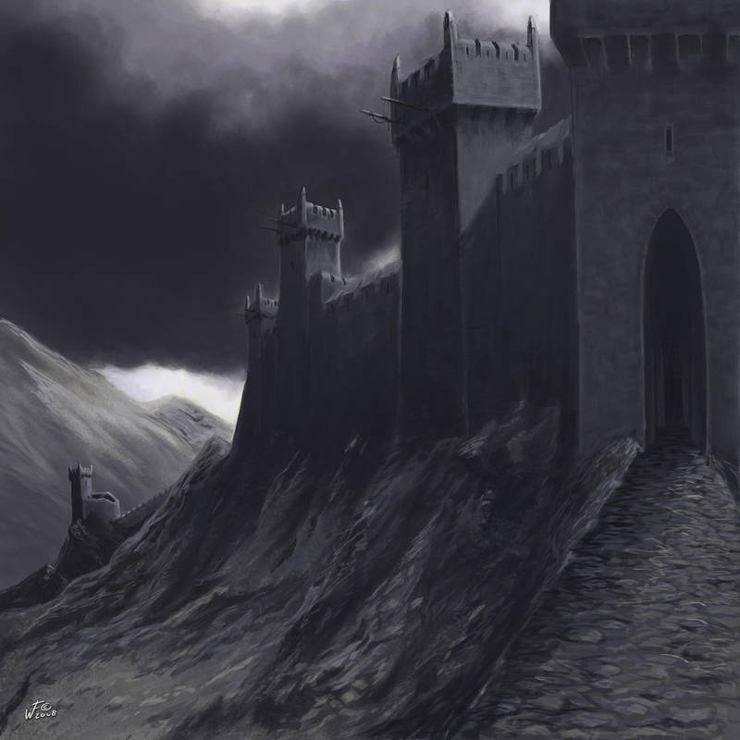
Even Rivendell is harassed. That’s right, Angmar dares to attack the Last Homely House. But its master, with his Ring of Power and his loyal tra-la-lally Elves, keeps even the Witch-king off his lawn. It would be amazing if Elrond had shouted after him with a shaking fist: “You trespass again, I’ll wash you down the river!”
But the watchtower of Amon Sûl (Weathertop), which because of its palantír had been a point of contention between the Dúnedain’s petty kings, gets creamed by the forces of Angmar. Then the Witch-king and his armies run roughshod over the rest of the north kingdoms. The former capital of Arnor has already been abandoned, but now its successor, the city of Fornost, is taken by Angmar as well. Things are not boding well, indeed; Rhudaur and Cardolan are all smashed by Angmar, so it’s just Arthedain left.
Yet even in these days of turmoil, those Hobbits who’d migrated into Eriador finally come into their own. They seek permission from the king of Arthedain to officially settle in those lush hills east of the Grey Havens, and they receive it. The Shire is thus founded around the year 1600 of the Third Age. The Hobbits even do their part—or at least they’ll claim to—by sending some archers to help out against Angmar. Whether that helps or not, for thousands of years, until Bilbo and Frodo really put it on the map, the Shire is basically flyover country (ridepast country?) in Middle-earth.
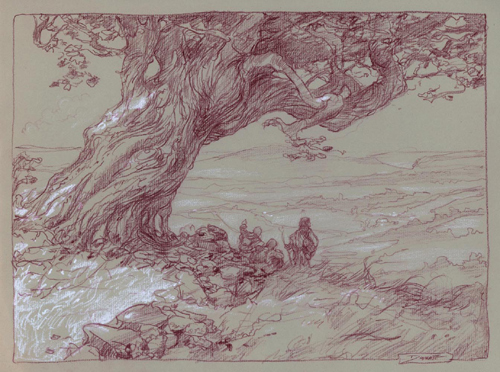
And they’re just fine with that. Adventures and wars make you late for dinner!
So one question is: where was Gondor when Arthedain and the other north kingdoms fell? Well, they have their own troubles, but they do send help and it does makes a difference. Gondor’s thirty-third king, Eärnur, is one worth knowing about for a couple of reasons. One, he’s the last king of Gondor before the Stewards have to step in to govern in their stead. But two, there’s an anecdote related to him that’s buried in the Appendices and worth pulling out for Lord of the Rings reasons.
When Eärnur (AY-er-noor) is still just a warrior-prince, his dad sends him with a fleet of Gondorians up to help Arthedain with its Witch-king problem. The Elves of Lindon join in, too. So Eärnur fights alongside such Elven celebrities as Círdan and Glorfindel…yes, the Glorfindel, the same Noldorin lord who gave his life at the fall of Gondolin but got re-embodied in the Halls of Mandos and then got shipped back to Middle-earth some point since.
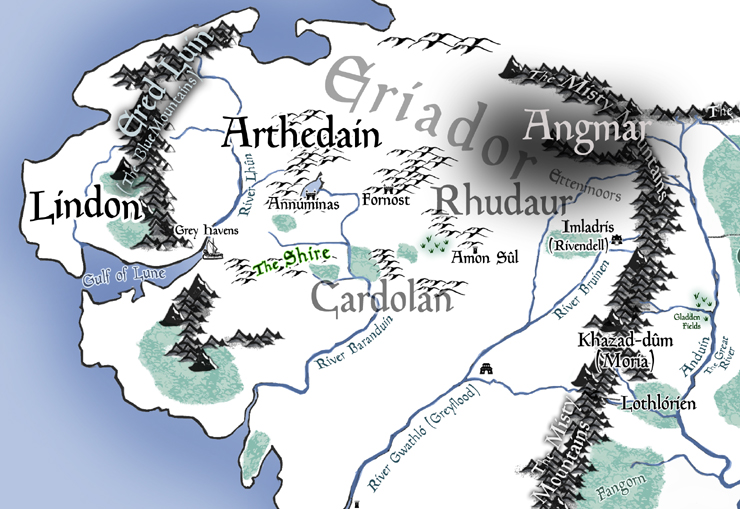
Well, even as Angmar’s forces are cut down by its collective foes, Eärnur gets the Lord of the Nazgûl’s personal attention. His personal hate. So the Witch-king calls him out, and Eärnur charges in, intent on single combat with the chief of the Nazgûl. He makes a beeline, ready to take him on, man-to-wraith. But Eärnur’s horse (understandably) freaks out in close proximity to the Nazgûl and he’s forced to retreat in front of everyone, in humiliation. When Eärnur tries to circle back to wipe the smug-yet-horrifying laughter out of the Witch-king’s mouth, Glorfindel restrains his mortal friend. The Elf then spouts a famous prophecy:
He will not return to this land. Far off yet is his doom, and not by the hand of man will he fall.
Ah, Calaquendi and their foresightedness. But c’mon, this prophecy is truly badass, given its later conclusion.
The Witch-king escapes, but his armies are finished off at Fornost by this actual “last alliance” of Men and Elves. Thus Angmar and Arthedain come to their ends at around the same time. And although Eärnur burns for a grudge match, he returns to Gondor and becomes its last king.
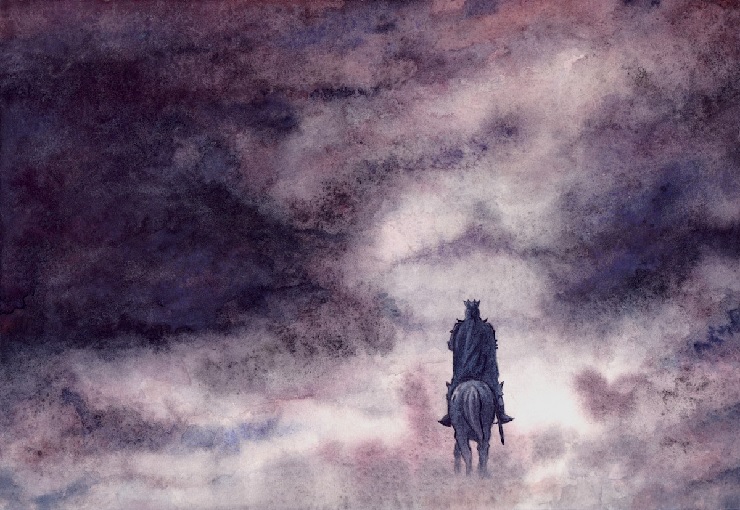
The Witch-king puts his Angmar days behind him, though, and shows up in Mordor, where he gathers together the other eight Ringwraiths (though a few are also later sent back to keep an eye on things in Dol Guldur). Now Mordor, still bereft of its Dark Lord but growing uncannily strong again, flexes its muscles and captures that old tower of Minas Ithil—the one right on its border, where Isildur had once lived. And yikes, this means Mordor now has its own palantír….
And in fact, this is when the Seeing Stones—that is, those still accounted for—are left alone. They’re no longer safe. There is doubt as to whether the palantír in Minas Morgul was destroyed or actually captured by Sauron’s servants. So with that in question they all fall out of known use.
Well, Minas Ithil is renamed by its new occupants to Minas Morgul, and thus the Witch-king gets a fancy new moniker: the Morgul-lord, morgul being Sindarin for “black arts.” But since the bad guys rebranded that tower, Gondor responds by rebranding Minas Anor to Minas Tirith—yes, a callback to Finrod’s watchtower in the First Age, which shares its name. By this point, the former capital city of Gondor, Osgiliath, has already fallen to Mordor’s attacks. So now Minas Tirith really is the foremost bastion against Mordor’s aggressions (as it is still in The Lord of the Rings).
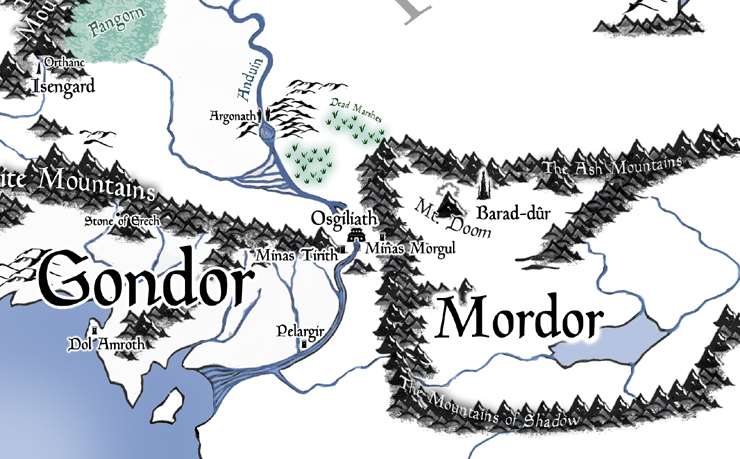
Then the Nazgûl chief sends out a challenge to King Eärnur to come and face him in single combat—for real this time LOL. Though Eärnur wants to answer it, his wise Steward restrains him. Seven years go by and the Morgul-lord renews the taunt. Is the King of Gondor chicken or what? Alas, this time Eärnur rides out alone right up to the gates…and of course the Witch-king cheats and has him captured, tormented, and eventually slain. Because why wouldn’t he?! So much for a fair fight. (Hey, remember when Morgoth’s emissaries pulled the same basic stunt on Maedhros?)
Thus the Stewards are left in charge of Gondor, figuratively keeping the throne warm for the return of…well, any king, any Númenórean descendant with legitimate claim to the throne. There simply aren’t any in Gondor these days, and even if there was someone up there in the broken north kingdoms, they’ve become scattered, “a strange people wandering secretly in the wild.”
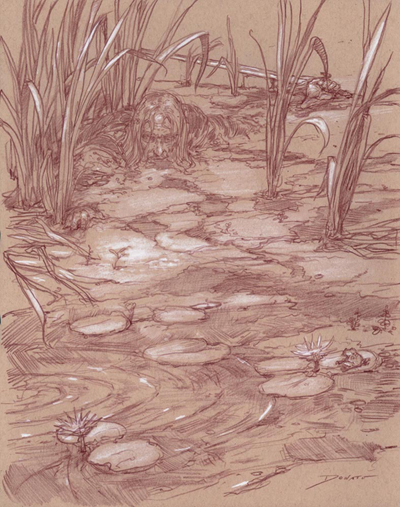
In other words, Rangers! They are a disregarded or even disdainfully regarded folk. So secretive! What are they up to!? But only the Dúnedain themselves and the Elves of Rivendell will remember who they are.
Now, this is a good time to wonder, hey, whatever happened to the Dwarves? Didn’t a bunch of them fight in the Last Alliance? What are they up to during all this? Well, they’ve been centered in Khazad-dûm (Moria) ever since, keeping their noses out of everyone else’s troubles, delving for that sweet, sweet mithril. And staying shut in their mountains have kept them safe for a while now. But, alas, under the reign of King Durin VI, they delve too deep…
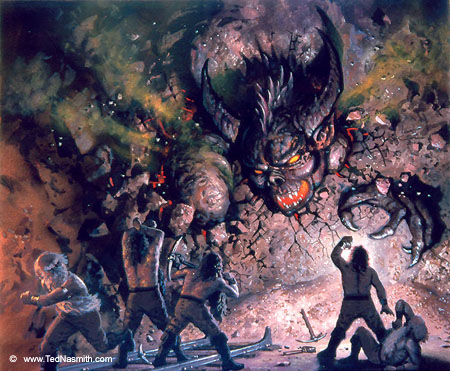
So that’s where the Balrogs ended up! Well, just one of them, anyway! This ancient spirit of fire has just been snoozing in the deeps of the earth ever since the War of Wrath. I suppose it’s little surprise that some would choose to hide out below the mountains reared by the OG Dark Lord long ago. But in seeking mithril the Dwarves have accidentally unearthed this horrific First Age monster, so a whole lot of them are slain—most notably Durin VI. One might connect the dots between this misfortune, the greed for precious metals, and one of the Seven Rings worn by Moria’s king…
of which evil enough after came to the profit of Sauron. It is said that the foundation of each of the Seven Hoards of the Dwarf-kings of old was a golden ring
I think it’s important to understand that good intel about this Balrog catastrophe doesn’t make it out into the larger world. Even the Elves of Lothlórien aren’t sure, calling it only the “Nameless Terror.” All people know is that something bad went down in Moria and now Orcs are squatting there. The Dwarves become refugees, scattering to various mountains holds—some to the Grey Mountains, some to the Blue. But one of Durin’s own heirs wanders east and founds the kingdom of Erebor, becoming the first King Under the Mountain. Yay, the Lonely Mountain is now on the map!
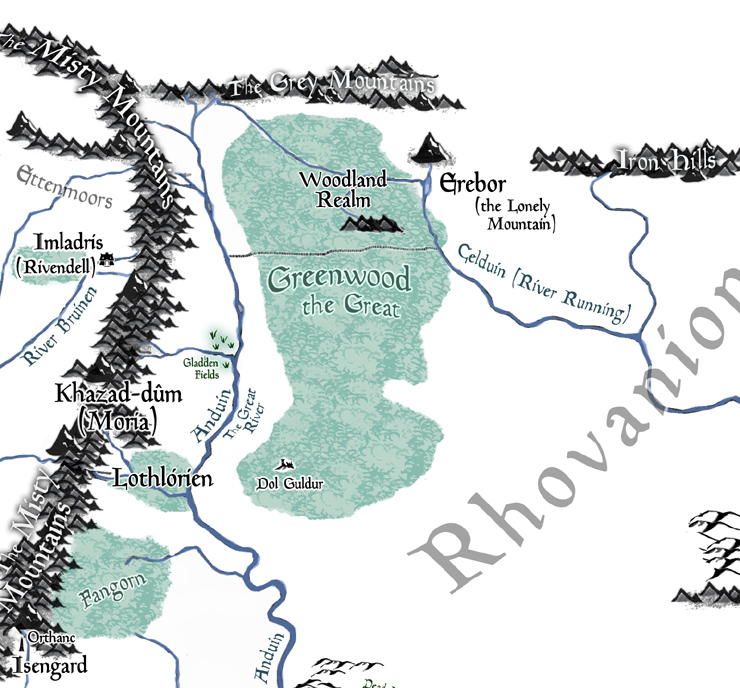
They also find the Arkenstone deep beneath the roots of the mountain. Now this remarkable jewel is no hallowed Silmaril (no!), but the Arkenstone sure means a lot to the Dwarves. Fortunately, there’s no accompanying Balrog lurking down there—so it looks like they’ll probably be untroubled by giant monsters.
Good on them! The Dwarves get a breather.
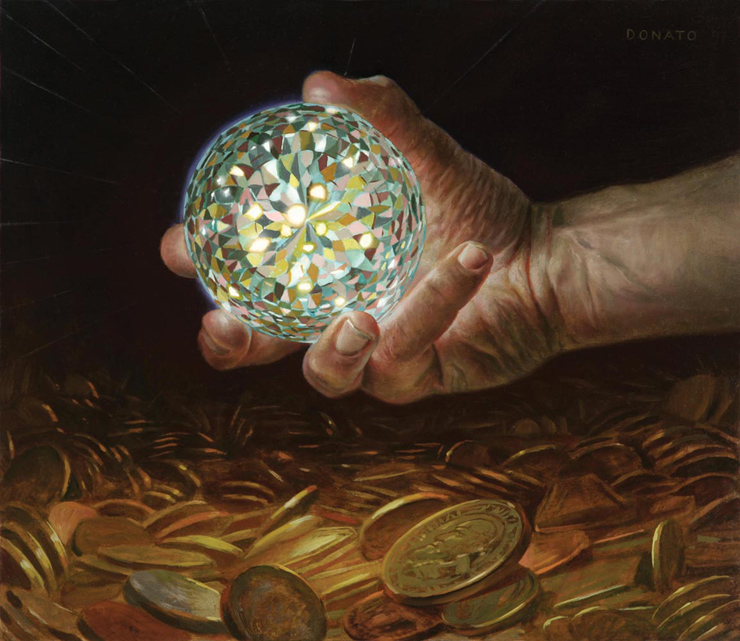
Now let’s go back to that Hill of Sorcery they call Dol Guldur in southern Mirkwood. You know, the one where Sauron has totally been hanging out. Well, now Gandalf actively goes there to snoop around—a risky venture, given his Istari restrictions, but if it’s just a Ringwraith as he thinks it is, he should be able to handle it.
Yet with one of the Wise sticking his nose where it doesn’t belong, Sauron is forced to slip out the back door. The Dark Lord’s trying to make a comeback here, and he can’t have these Wise guys all up in his business. He’s far from ready to return in might; he’s been playing this like a chess master doing his best to move his pawns (Orcs and evil Men) and knights (Nazgûl) around the board while remaining contained and hidden himself. Whereas in his heyday, Sauron was more like a king and queen combined, able to barrel over any foe personally when needed.
Once Sauron flies the Dol Guldur coop—far out East where he can’t properly coordinate his servants—there’s a long period of relative stability in the land. This is the Watchful Peace. I love that it’s Gandalf meddling in the Enemy’s affairs that initiates this long peace. Yet when it ends nearly four centuries later, it’s because Sauron sneaks back into Dol Guldur (through the bathroom window or maybe through a cellar door?) and directs his servants again.
Then some seriously momentous stuff happens.
For one, a river-dwelling, Hobbitish fellow named Sméagol finds the One Ring in the shallows of the Anduin (rather, murder-takes it from his cousin who found it). Sauron’s lost prize really didn’t drift that far from where it split with Isildur, did it? Which is so delightfully close to where he’s lairing right now in Dol Guldur, and yet the Dark Lord is totally unaware. He’s still not strong enough to sense it or arise with greater power. And so Sméagol keeps it, uses it like crazy, and devolves into the loveable scumbag we all know as Gollum. Gollum finds a new home in the Misty Mountains, taking it further under the radar than it already was.
Also around this time, the White Council is formed. It’s an exclusive club of ancient and high-profile elites, which includes Saruman, Galadriel, Elrond, Círdan, and Gandalf, who basically agree to keep an eye out for Sauron’s return and work to oppose him. What with the Istari having mostly scattered, the White Council is sort of like their unofficial replacement. It meets infrequently, talks a lot, but doesn’t necessarily take much action. Gandalf pushes it to do more, but usually it’s Saruman, who is head of the Council, who holds it back.
And that’s because Saruman is kind of a know-it-all jerk, or gearing up to be one. He hasn’t fallen to evil yet, but the more he learns about Sauron the less he wants to merely defeat him and the more he wants to replace him entirely. Interestingly, he’s not living in the tower of Orthanc just yet. He’s still out and about, probably moving from one big house to another among Men.
And speaking of Men: with Arnor long gone and Gondor faltering a bit, the boundaries of the southern kingdom are a little shaky. Fortunately, there are some scrappy horsemen on the scene who help Gondor deal with persistent invaders—usually Orc raiders from the Misty Mountains, but also plenty of troublemaking Men who weirdly preferred the tyrannical yet trains-running-on-time regime of Sauron. For this timely assist, the Steward of Gondor gives these horsemen free ownership of the plains of Calenardhon, which lie on its northern border, just over the White Mountains.
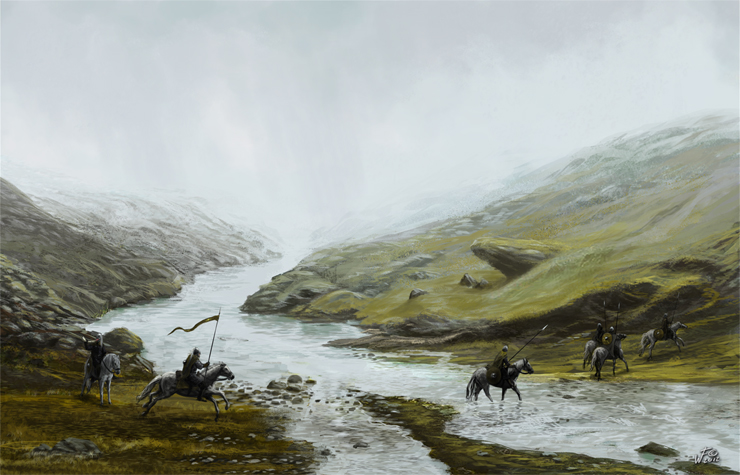
The first ruler of this rebranded landscape is one Eorl the Young and his new kingdom is called Rohan, or the Riddermark (“land of the riders”). Enter the Rohirrim! Woo! These people are actually descendants of the Men who didn’t go as far as Beleriand in the First Age but were part of the same kindred who went on to become the Elf-friends—the Edain! So they’re like very distant cousins to the Men of Gondor.
Anyway, they’re totally going to be best buds, Rohan and Gondor. And their shield-maidens are going to be especially badass, just you wait and see.
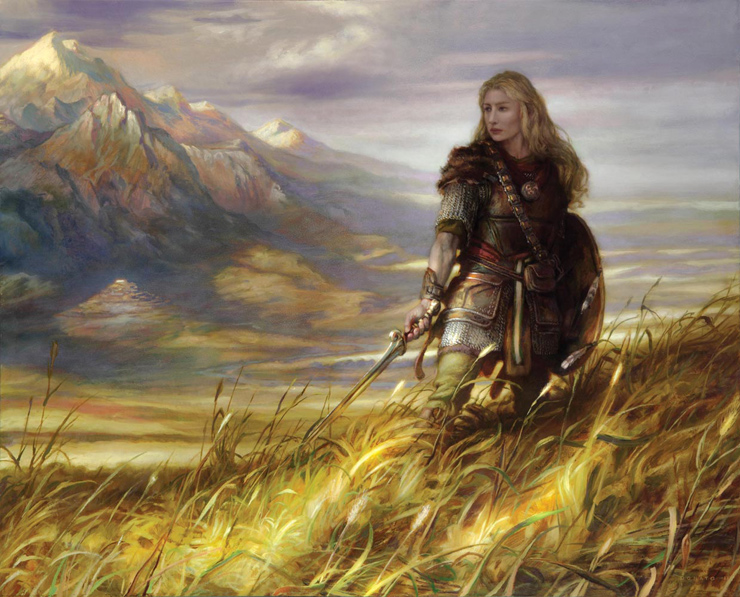
Speaking of Orc-raiders, one day Elrond’s wife, Celebrían, is captured by some when she is traveling between Rivendell and Lothlórien (to visit her parents, Galadriel and Celeborn). Though she is tormented by the Orcs, her sons rescue her and she is brought back to Rivendell for healing. But she suffered too much at her captors’ hands. There is insufficient therapy in Middle-earth to help her, so she soon after sails to Valinor, leaving her husband and children behind until their time to sail West comes. It’s a testament to his commitment to helping Middle-earth that Elrond doesn’t hand off his Ring of Power to someone else and go with his wife. Poor guy. Elrond’s family has more reasons than most to hate Sauron.
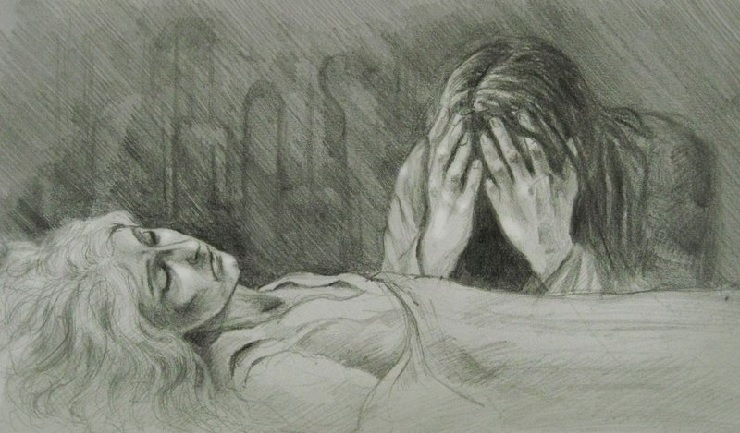
Meanwhile, up by the corner of Gondor and the Misty Mountains, Isengard gets a new tenant: Saruman. He actually signs on as a lieutenant of Gondor, a sort of border security specialist, and the Steward gives him the keys to the black-stone tower of Orthanc. And as Appendix A tells us, “in this way Saruman began to behave as a lord of Men.” Which is kind of not okay for one of the Istari, and yet no one calls him out on this. He’s still the head of the White Council and has the respect of his peers. He has a persuasive voice.
He still seems to be aboveboard.
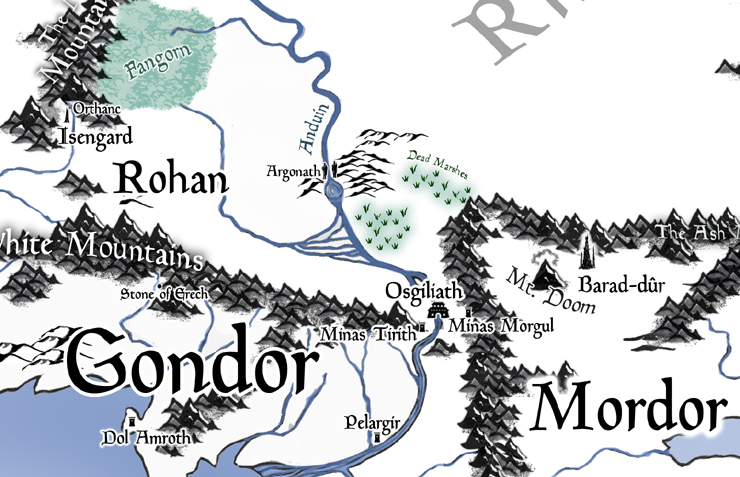
Oh, and inside Orthanc is one of the palantíri. A fortuitous treasure? Well, no. Also from Appendix A:
Though afterwards there was little doubt in men’s minds that Saruman went to Isengard in hope to find the Stone still there, and with the purpose of building up a power of his own. Certainly after the last White Council (2953) his designs towards Rohan, though he hid them well, were evil.
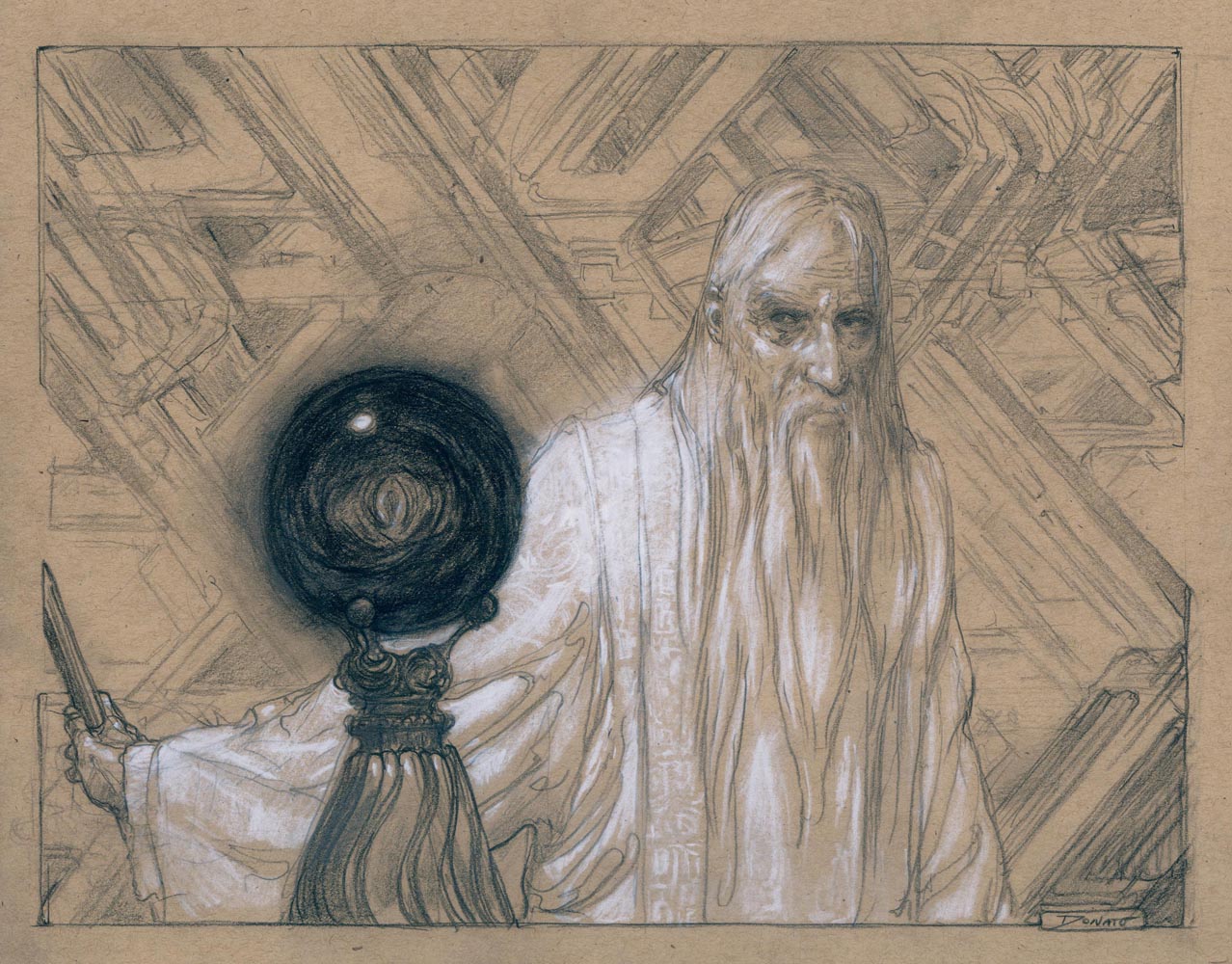
Now, about forty years after Saruman moves into Isengard, that newer Dwarf kingdom based in the Lonely Mountain is, sadly, troubled by a giant monster after all. Fortunately, it’s not a Balrog this time. But unlike a Balrog, this creature has wings.
An uppity fire-drake from the mountains, who’s heard of Erebor’s fabulous wealth, comes swooping down from the north with fire and greed. This is the progeny, maybe, of one of those Angband dragons that survived the War of Wrath. He’s winged, after all. Thus Smaug the Tremendous destroys the city of Men near the mountain and claims the Lonely Mountain and its great treasures as his own.
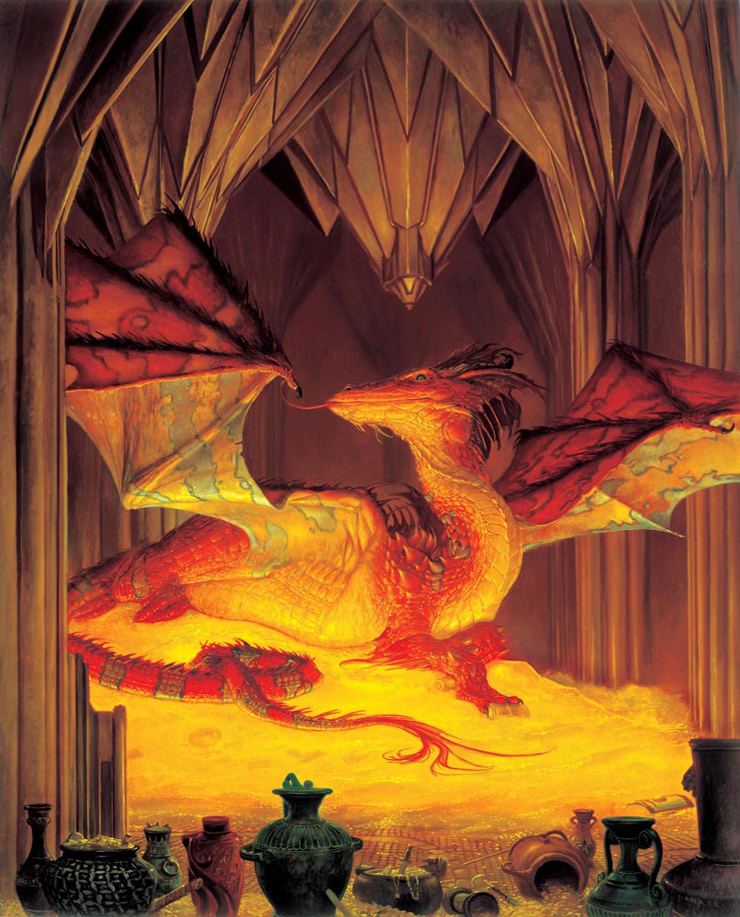
The Dwarves go on to war with the Orcs who occupy Moria, and that doesn’t go well, either. After the subsequent death and disappearance of its most recent heirs, one Thorin Oakenshield becomes the new king-in-exile of his people.
Gandalf, freewheeling maverick that he is, sneaks into Dol Guldur again and this time confirms the presence of Sauron. Yikes! He then tells the White Council about it, but still Saruman overrules any decision to attack the Enemy there. Why? Because now the White Wizard regards Sauron as a true rival; he wants the One Ring for himself, and he now knows that Sauron is actively searching for his lost treasure. And if the Dark Lord’s spies are picking up clues, then maybe Saruman can piggyback on that and scoop the Ring up first.
But Gandalf won’t wait forever. He doesn’t know of Saruman’s secret lust for the One Ring, but the Grey Pilgrim can’t be tied down. He keeps doing his thing, and one day has a chance encounter with Thorin Oakenshield near the village of Bree. Not liking the overall state of things in the North—the presence of Smaug, the dragon’s desolation, and the resultant accessibility of Angmar to servants of the Enemy, Gandalf decides to set some things into motion.
So now we can insert the entire plot of The Hobbit: Bilbo emerges as the hobbit of the hour, scores the One Ring from Gollum without knowing how a big a deal that is, and helps the Dwarves of the Lonely Mountain win back their home through both hapless and volitional choices. Thorin Oakenshield becomes King Under the Mountain, Erebor is restored as one of the great Dwarf kingdoms of the age, but at the cost of far too many lives.
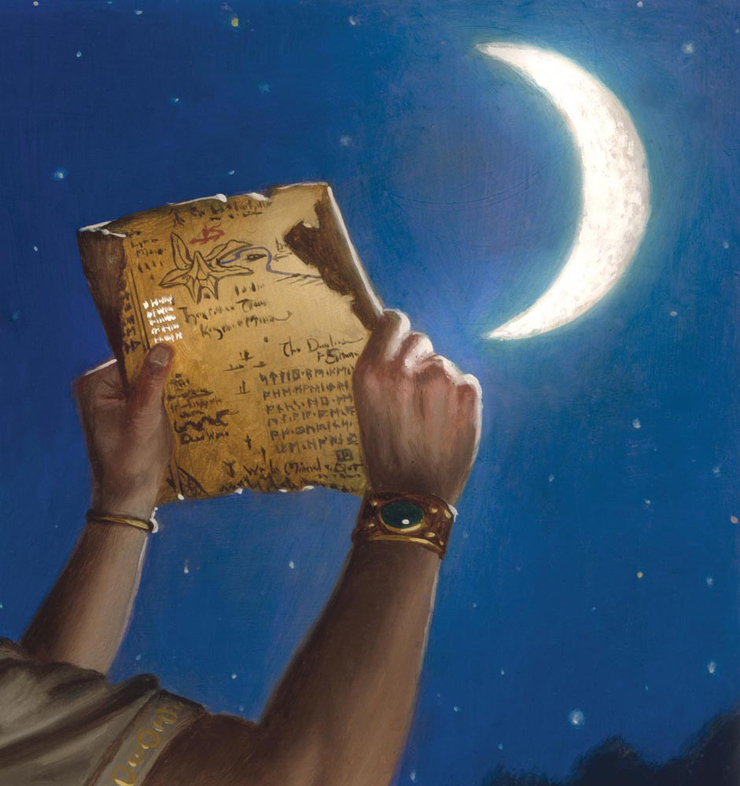
Meanwhile, the White Council finally listens to Gandalf and decides to take action…which is to say, Saruman finally lets it take action. Why? Because Saruman thinks the Dark Lord is now getting too close to finding the One Ring. By this point, Saruman has already learned that the Ring disappeared in the Gladden Fields, and that’s where Sauron has had his spies searching. Time to kick him out of there. So as a united force, the White Council advances into Dol Guldur and gives the Enemy the boot. Which Sauron is actually fine with, this time. He’s all, “Oh no, you found me! I’d better run!” He flees dramatically but then goes, nice and quiet-like, to Mordor again. Time to oversee the reconstruction of Barad-dûr.
Now, in the wake of Bilbo’s adventures, the One Ring is in the Shire! And Gandalf ain’t telling nobody about his little friend’s new prize. Best to keep it way down on the down-low. He knows it’s probably a Ring of Power, but he doesn’t yet think it can be the One Ring to Bind Them. Maybe it’s one of the lost Seven, or one of the many other lesser rings made by the Elves in the Second Age. Either way, the Shire and its people need looking after. And since Gandalf is friends with the Rangers—because of course he is!—he asks them to “set a watch upon the land of the Periannath.”
This part of this chapter, and the whole legendarium, makes me think of Melian’s words to Galadriel back in the First Age, back when Men first showed up in Beleriand:
Now the world runs on swiftly to great tidings.
It’s not like the Third Age has been quiet. Obviously, it hasn’t. Men and Dwarves have been warring with the messy remnants of Sauron’s once-great power, while Elves stay vigilant even as their role in Middle-earth has dwindled to almost nothing. But now Sauron is really ramping up. Time has been on his side as an immortal Maia of Morgoth’s tutelage. Now he’s regained enough of his former power to truly search for the One Ring. First he captures Gollum, and learns that his precious treasure has indeed been found! Time to prep the Nazgûl for some recon!
If Sauron gets his Ring, the world of Men will go down hard. I mean, who can stop him? There’s no Gil-galad this time, no Elendil the Tall, no Last Alliance. The Elves are too weak and too few, and the blood of Númenor? Gone.
Oh, wait. There is that one line of Dúnedain chieftains whose ancestry runs back all the way through the Kings of Númenor, and the original Elf-friends of old, and Eärendil himself, and thus to all the different kindreds of the Eldar, not to mention Lúthien and her Maiar mom.
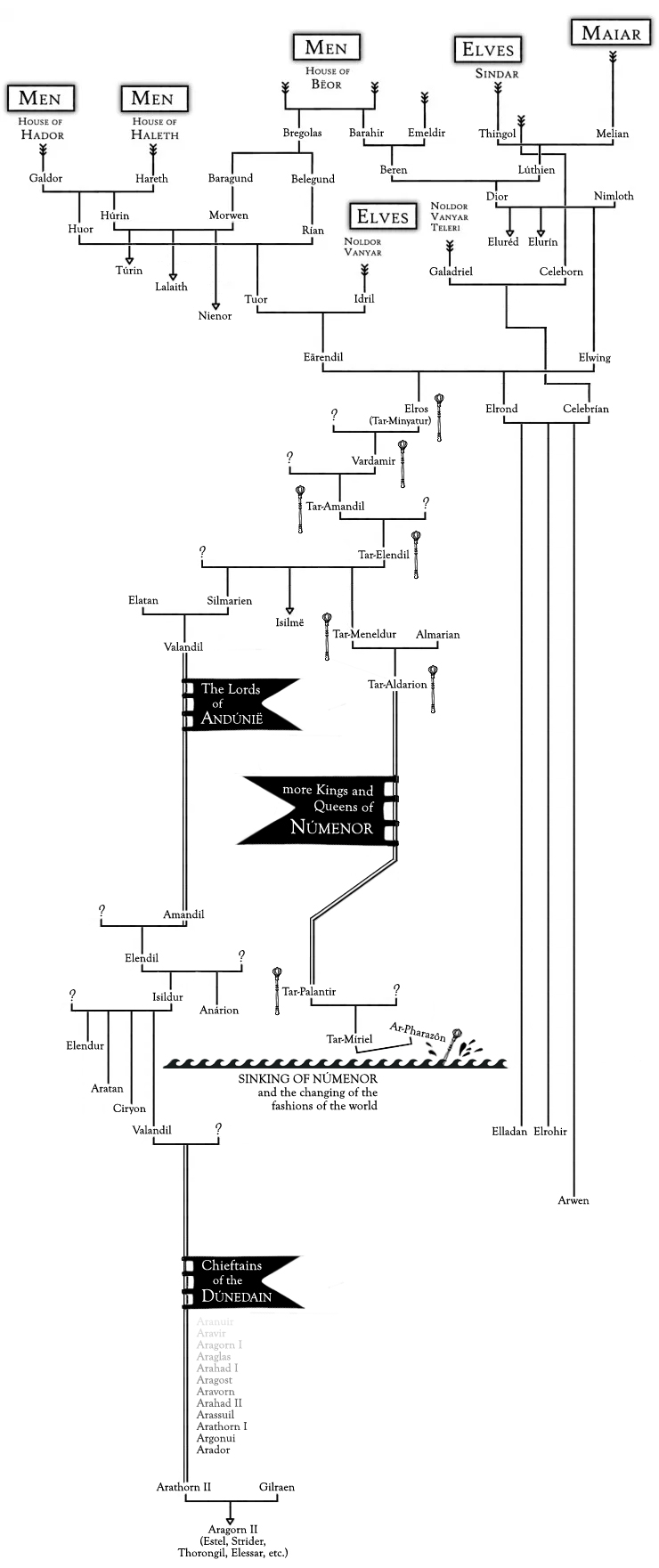
The latest of this line is young Aragorn II, son of Arathorn II. Arathorn is taken out of the picture the same way Tuor’s dad was (Orc-arrow in the eye!), and so his boy is fostered by Elrond in Rivendell. When he comes of age, Aragorn learns of this heritage, and the weight of history falls upon him. Like Beren, a high doom is on him, and also like the One-handed he meets and falls in love with an Elfmaid of supremely higher lineage: his foster dad’s daughter! It happens in a similar fashion, too.
But to win Arwen’s hand, he’s got a lot to do. And again like Beren, Aragorn’s got a rough road ahead, to achieve a seemingly impossible task, which is set before him by Elrond (but at least not handed to him in a wrathful, Thingol-like way). Instead of retrieving a holy gem from the headgear of an evil Vala, this scruffy Ranger who “looks foul and feels fair” must gain the throne of Gondor and unite the North to challenge the great Enemy and save the world. That’s all.
Aragorn starts by going out into the wild, and the wider world, where he earns more names and titles than Túrin Turambar—if that can be believed. He helps many people against the rising shadows of Mordor. Under a slew of aliases he fights in Rohan, he fights in Gondor…
and went alone far into the East and deep into the South, exploring the hearts of Men, both evil and good, and uncovering the plots and devices of the servants of Sauron.

History will rightly compare him to his First Age forebears. But then he circles back and settles into the role of Ranger whom the Men of Bree call Strider. And his friend Gandalf even enlists his help to keep an eye on things near the Shire.
And now at last we can drop into this exposition the full plot of Tolkien’s most famous novel, Of the Halfling’s Trove and the Fall of Sauron. No, sorry, I’ve grown too accustomed to Silmarillion chapter titles. Rather, The Lord of the Rings, wherein Frodo, while he still has ten fingers, steps up and takes Bilbo’s funny magic ring on a big adventure.
There’s loads of action even early on: a big birthday bash, fireworks, discussion of real estate at Bag End, the intervention of a singing forest-weirdo, and freaky barrow-wights. There’s even some chase scenes.
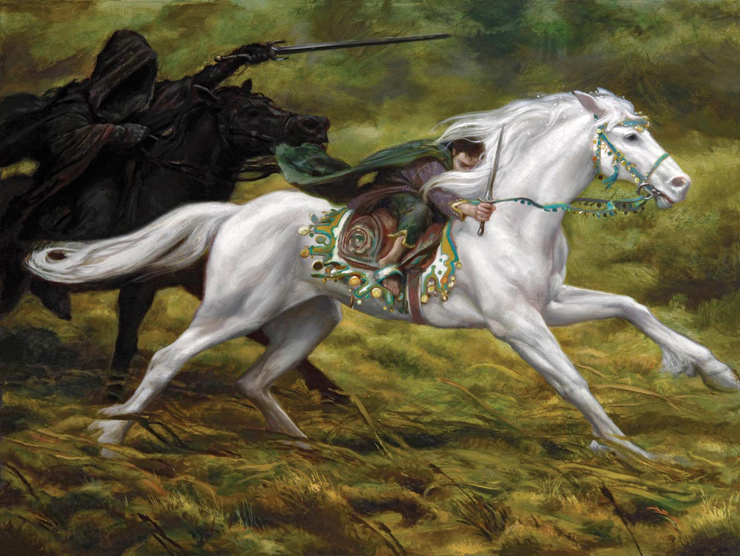
Saruman finally reveals his true and Many Colours and tries to keep that nosey-posey Gandalf from keeping the One Ring out of his hands. But Radagast busts his old friend out—indirectly and unknowingly—with the help of the Third Age’s foremost Eagle.
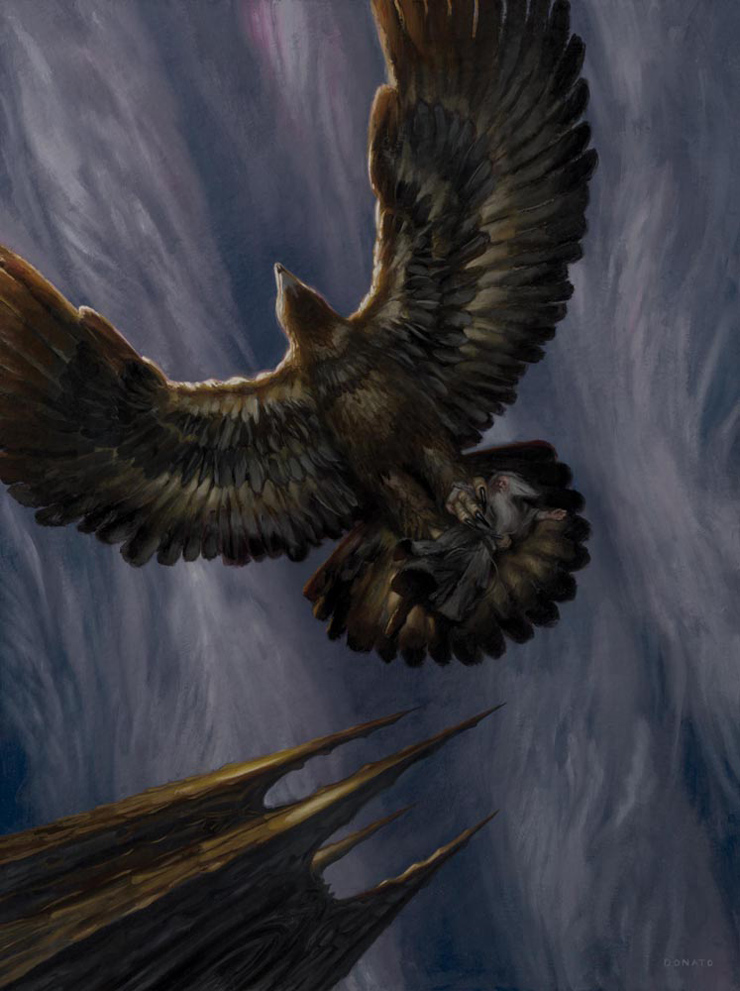
Frodo goes on to meet some really cool people. After chilling in Rivendell, he travels in style with a nine-fellow Fellowship: there’s a Man of Gondor, a Dúnedain Ranger, an Elf-prince of the Woodland Realms, a Dwarf of Erebor, one Istar, and three of his Hobbit buddies. If things weren’t so precarious for the world, this would be the ultimate party-time road trip!
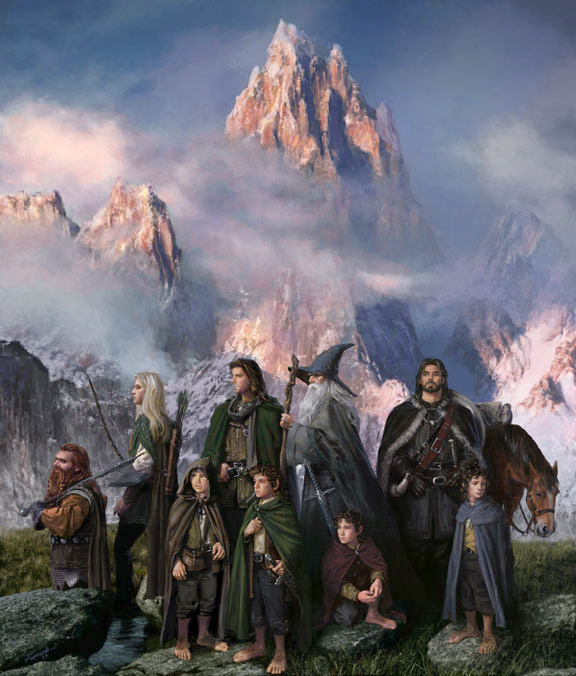
They end up walking a lot—and through some really rough weather, too.
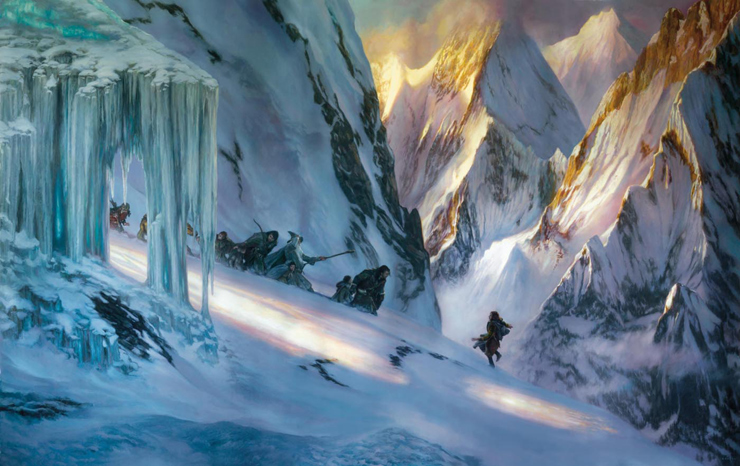
And no, they can’t just ride Eagles the whole way. That’s for damned sure. Those’re Manwë’s special ops.
They (temporarily) lose their Istar, but it’s only because he tangles with Durin’s Bane—you know, that Balrog from the old gang back in Angband—in the deeps of Moria. That’s right. Gandalf has to do the work of five Maiar.
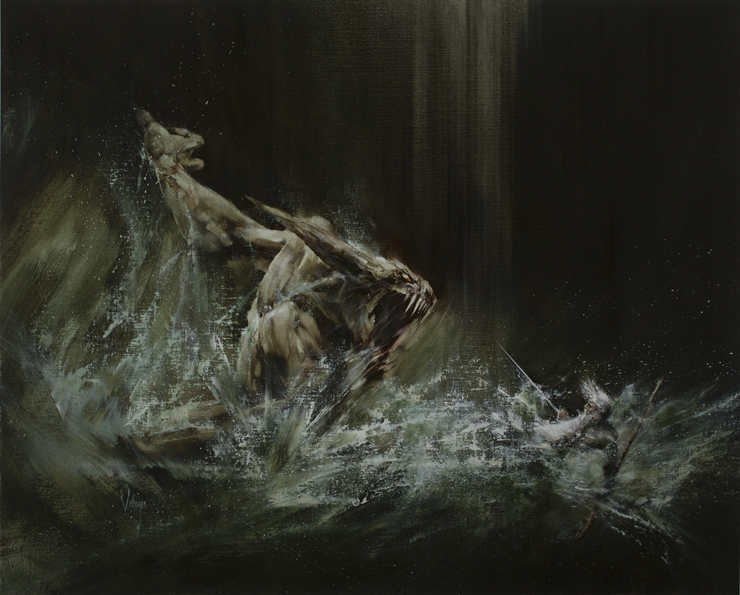
Then the Fellowship go on to meet Galadriel, and Frodo is totally “the footsteps of doom” to her. Because even if he succeeds in getting rid of Sauron’s Ring, her own Ring of Power will lose its potency. Then Lothlórien and all her tarrying in Middle-earth will be ended. Poor Galadriel; for thousands of years, ever since Valinor, all she ever wanted was go to Middle-earth and rule over a realm of her own. Now she’s finally done it, kinda sorta, and then this little Halfling comes along to presage the end of it all. Girl can’t catch a break.
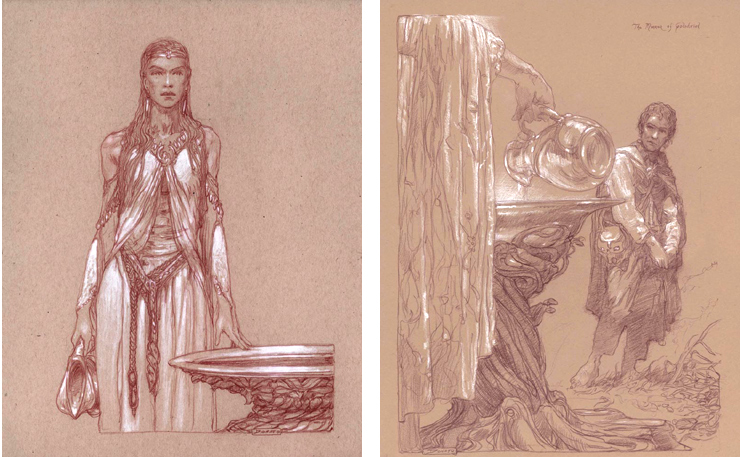
Lucky for us, she’s one of the good ones—and only with her help do these now-eight fellows, laden with gifts and good advice, go on with renewed courage. But soon after, they lose another friend, the Man from Gondor. The incident bums them all out and even splits up their party.
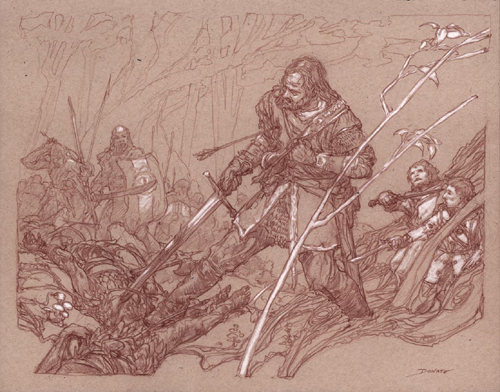
Then Frodo and his gardener run into Gollum and the trio get along…well enough, I guess. Sure, the relationship has some rough patches. At one point, Frodo’s even forced to use a bit of secondhand Silmaril-light from Eärendil’s headlamp to stave off Ungoliant’s last kid. (Thanks, Galadriel, for bottling that up for him!)
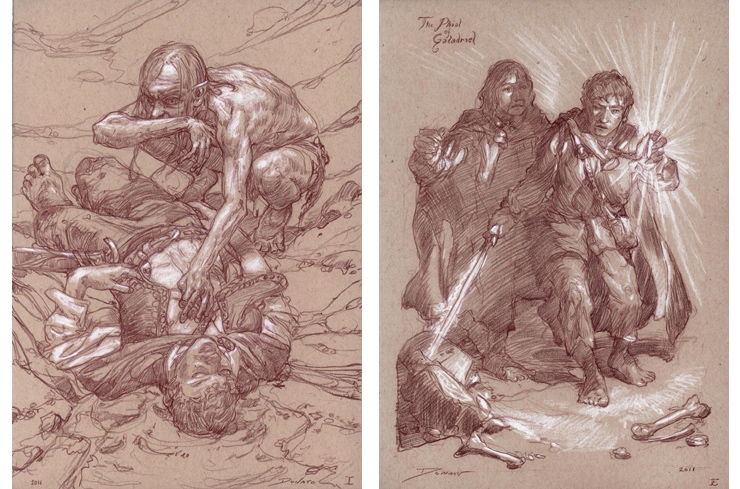
But then the remaining Man, Elf, and Dwarf of the group jog through Rohan and scuffle with Saruman’s own brand of Orcs. Which…c’mon, Saruman! This is basically the opposite of what you agreed to do in Middle-earth! Such a jerk.
Then Frodo’s cousins meet the shepherds of the trees! See, Yavanna totally called it: the Ents were in the Song (the Music of the Ainur itself), and now it turns out they have a big part to play in negating the threat posed by Isengard’s rogue Maia. You go, Giver of Fruits!
So yay, Ents are back on the scene! This time they’re more than just bit players. (We’ve not seen them since their cameo in “Of the Ruin of Doriath”!)
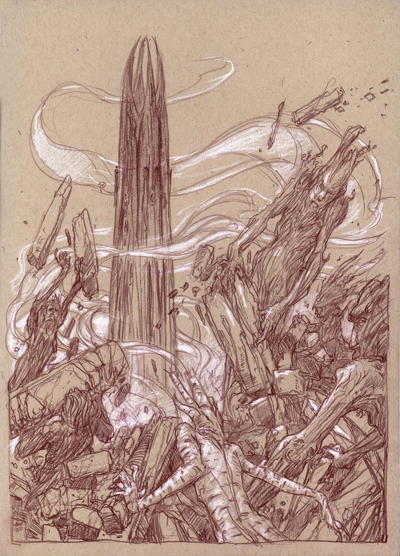
Later, when the leader Ent meets the Dwarf of the hour, I bet Yavanna and Aulë exchange knowing, nervous looks, way over in Valinor. But it turns out okay. They’re all friends now.
Then things move at last to Gondor, where Minas Tirith is still being pestered by the forces of Mordor. But behind the scenes, Aragorn, the heir of Isildur, and a ragtag group of Rangers go and summon those good-for-nothing Oathbreakers that Isildur cursed back in the Second Age. Now at last they are good for something; they redeem themselves, and this allows Aragorn to join the party, with force, on the fields in front of Minas Tirith.
And it’s right there on that field of battle that the Witch-King finally gets what’s coming to him—his just desserts.
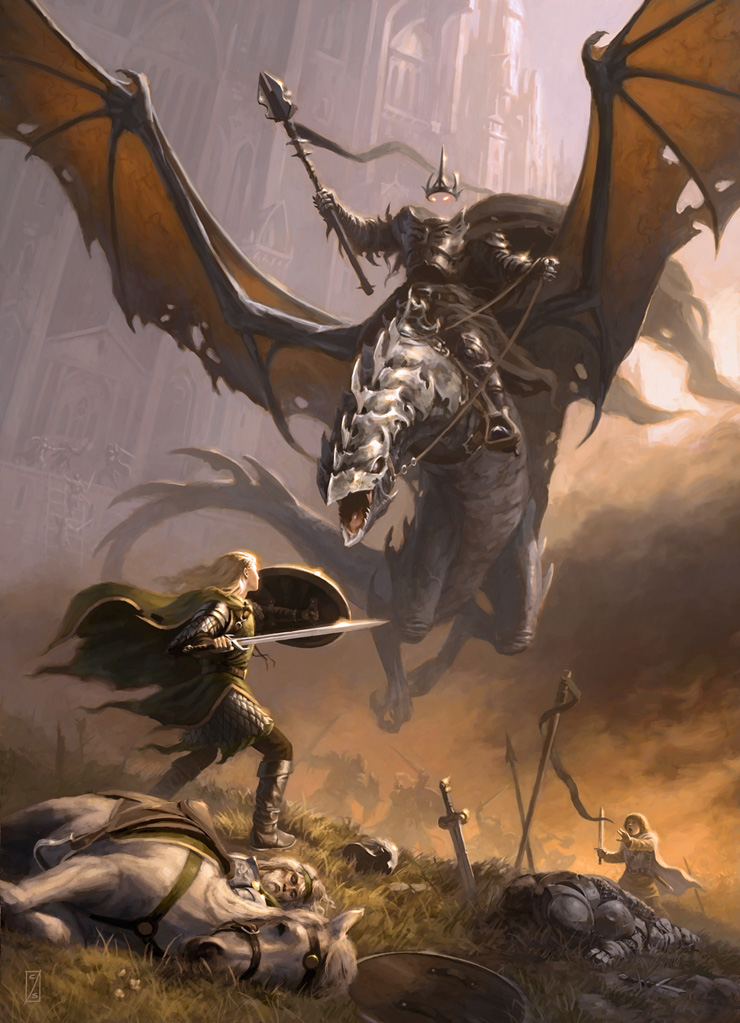
” by Craig Spearing
Which is to say, one of those shield-maidens of Rohan comes between the Nazgûl and his prey and then hinders the shit out of him (with a timely assist from a nearby Hobbit friend).
If the Witch-king had been able to chit-chat with his boss afterwards (not a chance), Sauron might have commiserated and told him about the time he seriously underestimated a girl in the First Age. It’s almost like the bad guys don’t take the women of Middle-earth seriously enough, either. Well, too bad for them. But it’s not like they didn’t have precedence for this. Morgoth himself feared Varda, the Lady of the Stars, above anyone. And now, somewhere, Melian is probably rolling her eyes…and cheering!
But anyway, Frodo and his gardener slog into Mordor at last, bearing the One Ring to the last place in the world that Sauron would look, and which Isildur once had so close at hand: Mount Doom!

There, the Hobbits get the job done at last. It isn’t easy, and Frodo falters in the end. But because of the pity he learned from Gandalf (who in turn learned from Nienna!) and also because of his own Ring-based contingencies, he’s made sure that Gollum is there at the eleventh hour to bite off the offending finger.
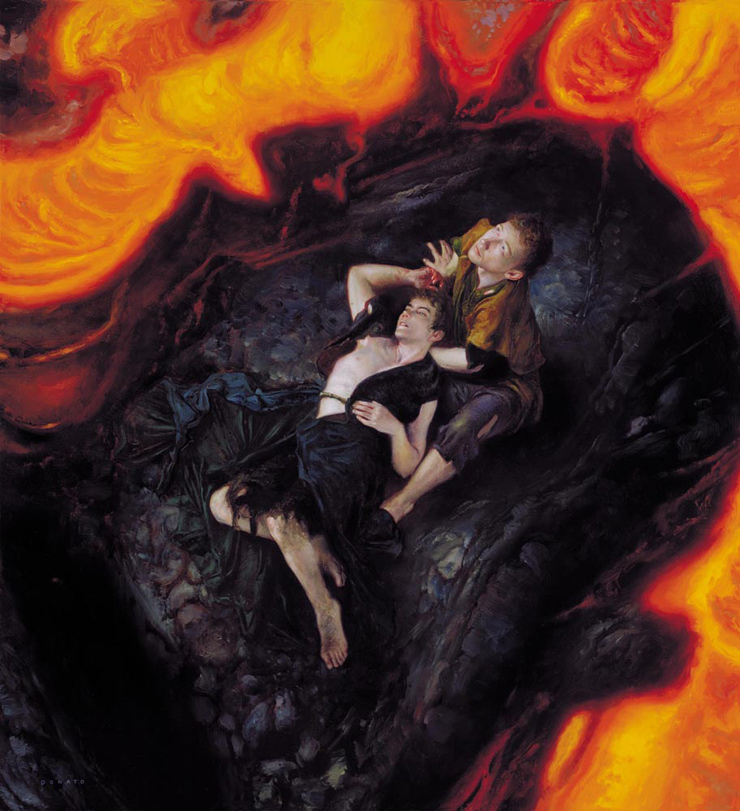
The One Ring To Rule Them All is therefore unmade. Barad-dûr and its foundations crumble at last, and the Dark Tower’s chief occupant is reduced to an impotent shadow of malice. The Hobbits have saved the Shire! And the whole mortal world.
Aragorn unites the lands under the banner of Gondor and Arnor, so he gets to marry his foster dad’s Elf-daughter. His wife then makes the same choice as Lúthien, so she, too, will be counted among Men and go beyond the Circles of the World when she dies.
Gandalf then helps Aragorn find a surviving seedling of that White Tree, so it flowers and grows again. Yay! Then Gandalf’s irresponsible former supervisor, Saruman, sticks around long enough to cause some further trouble in the Shire. It’s rather pathetic. The bad Maia is reduced to merely pushing around Hobbits in their homeland, but they thwart him in the end without even needing help from any Men, Elves, or other Istari.
Though they are mere mortals, Frodo and Bilbo are eventually grandfathered into the Valar’s Elves-only policy of sailing on the Straight Road to the Undying Lands. As former bearers of the One Ring, they’ve suffered much and earned a special place in paradise, short-lived as it may be for them. Círdan is cool with this, and anyway all of the Wise are departing, too. Footsteps of doom, and all that.
But of course, anyone reading this knows that part of the story. Yet The Silmarillion ends not like The Lord of the Rings, with the departure of Frodo and the return to the Shire of the hero-gardener of the age. It doesn’t merely end with the baton being handed off to Men as the Fourth Age begins.

Remember, this book is chiefly the story of the Elves, especially of the Noldor. So it largely ends with the departure of the last of the Noldor, which would be Galadriel, Glorfindel, and maybe a few others. Galadriel really, really needs a family reunion in Valinor—her mom, her dad, her brothers! So much catching up to do. (She’ll be pleased to find out that Finrod finally settled down with a nice girl from the old country.) Interestingly, Celeborn stays behind for a while. He might even be the last of the Eldar to depart at some unspecified date.
But the book truly ends with the focus on Elrond, who is sort of the symbolic link between the Elder Days and this dawning age of Men. His dad is Eärendil the Mariner, who still sails the skies with a Silmaril strapped to his head; he is a symbol of hope for all of Arda, and his efforts helped bring Morgoth down in the First Age. Elrond’s brother was the first king of Númenor. And now his daughter is the neo-Lúthien of the age, who’s just married the last descendant of Númenor.
With the departure of Elrond Half-elven, loremaster of all the greatest legends of Middle-earth, things wrap up rather smoothly and symbolically.
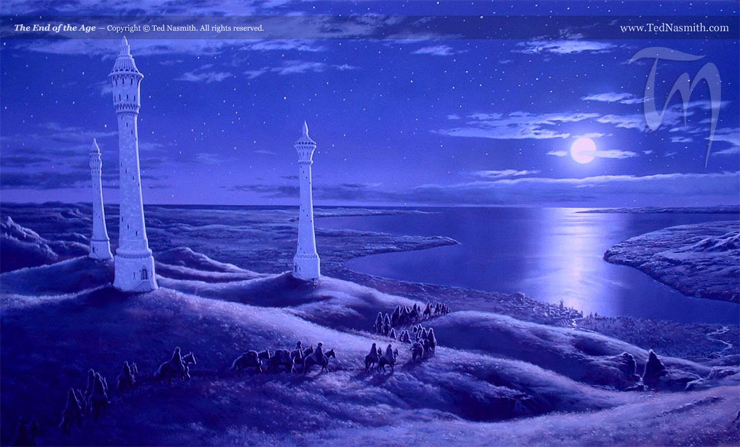
Although he’ll depart someday, too, Círdan the Shipwright does what Teleri Elves do best: he tarries a bit longer. He’s still standing on the shores of Middle-earth, waiting to pick up any stragglers—like, perhaps, Elrond’s twin sons, whose ultimate fate is mysterious, as they don’t leave when their dad does. (But it would be unsurprising to learn they stuck around a good long while, mopping up Orcs with grampa Celeborn.) It was Círdan who helped make the ship used by that whippersnapper Eärendil (before the Valar re-made it), so it’s only fitting that it’s he who made the ship that bears Eärendil’s boy into the West, too.
And so off Elrond goes, leaving the “Bent World” and its “round sky,” a very different place than it was when he was born! As the Straight Road lifts him towards the Uttermost West, I like to think he sails past Vingilot and gives a thumbs up to Pops on the way out.

Well…that’s it, folks!
I’d really like to thank you all for reading along in this series, as well as all the amazing artists who gave me permission to share their work. And even more especially my brother, John, for his general proofreading and often-specific witticisms throughout. But I’d also like to point out, again, that The Silmarillion (like any of Tolkien’s books) is the sort of work that will eternally fascinate and offer new nuggets (nay, gems) of insight with each revisit. Does that mean should you flip back to page 1 and start with the Ainulindalë all over again? Not necessarily.
Go listen to some fun people talk about it first. Then read some other stuff. Then come back to it. And I do have recommendations, podcasts that have inspired me, like the ones hosted by Dr. Corey Olsen: The Tolkien Professor, Mythgard Academy, Mythgard’s Exploring The Lord of the Rings, etc. Then there’s…
The Prancing Pony Podcast: These guys traversed The Silmarillion in their first season. In Season 2 they walked along with Bilbo in The Hobbit, and now in Season 3 they’ve only just begun down the road that goes ever on and on in The Lord of the Rings. Alan Sisto (the Man of the West) and Shawn Marchese (the real-life Lord of the Mark) are a blast to listen to…provided you can handle that much dad humor.

The Green Door Podcast: Very much worth your time! This trio of podcasters (two Canadians and a Brit) are much newer, and have only recently delved into The Silmarillion. While they’re not walking through it moment by moment, James O’Flaherty, May K. Hella, and Adam “Ads” Hillier really throw themselves into some wonderful discussions—offering some refreshing and original points of view on Tolkien’s tales. I even “guest starred” in Episode 12 via palantír. They’re a lot of fun. Is it possible to seem and feel fair? They do.

Anyway, all of the above ensures a steady stream of never-ending Tolkien discussions. There’s no such thing as tarrying overlong in Middle-earth.
Top image from “The Fellowship in Hollin” by Donato Giancola.
Jeff LaSala can’t leave Middle-earth well enough alone, and will probably look for more excuses to keep talking about it. His follow-up series Deep Delving into Middle-earth continues the theme of Tolkien excavation. Tolkien geekdom aside, Jeff wrote a Scribe Award–nominated D&D novel, produced some cyberpunk stories, and now works for Tor Books. He sometimes flits about on Twitter.










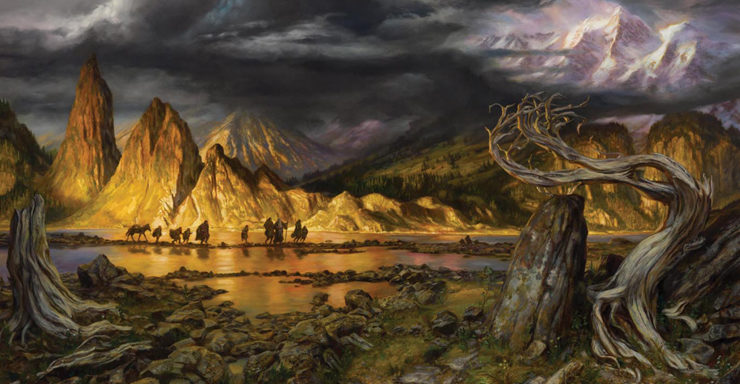
And this the Valar did, desiring to amend the errors of old, especially that they had attempted to guard and seclude the Eldar by their own might and glory fully revealed; whereas now their emissaries were forbidden to reveal themselves in forms of majesty, or to seek to rule the wills of Men or Elves by open display of power, but coming in shapes weak and humble were bidden to advise and persuade Men and Elves to good, and to seek to unite in love and understanding all those whom Sauron, should he come again, would endeavor to dominate and corrupt.
Or, as one of Tolkien’s contemporaries put it:
Your ideal position is when you are present and not noticed. Do not be too intimate, too prominent, or too earnest. Avoid being identified too long or too often with any tribal sheikh, even if C.O. of the expedition. To do your work you must be above jealousies, and you lose prestige if you are associated with a tribe or clan, and its inevitable feuds…Do not try to do too much with your own hands. Better the Arabs do it tolerably than that you do it perfectly. It is their war, and you are to help them, not to win it for them.
@1
First time I’ve seen T.E. Lawrence as a Maia.
I wonder if Peter O’Toole would’ve been a good Gandalf.
Hi Jeff,
I just want to give a hearty thank you for this primer. I’ve been following along since the start, as I know many of the other commenters have been as well, and I cannot put into words how thankful I am for your work here. It has helped me rediscover my love of Tolkien, as well as delve further into his works than I had before. And luckily for me, Durin’s Bane isn’t waiting for me as I continue my journey.
Thank you so much for this series Jeff, our very own loremaster! This has been a fortnightly highlight for the last year and I will miss your witty Middle-earth musings, well done good sir!
Thanks, guys. This won’t be my last Middle-earth nerd-talk, for sure, just the last of this series. One thing I will be circling back to soon is Tolkien art and artists. Be on the look-out for that. ;)
I wonder if Peter O’Toole would’ve been a good Gandalf.
Oh, without a doubt. And Anthony Quinn as Thorin?
” I carry twenty-three great wounds, all got in battle. Seventy-five men have I killed with my own hands in battle. I scatter, I burn my enemies’ tents. I take away their flocks and herds. The Turks pay me a golden treasure, yet I am poor – because I am a river to my people!”
And surely Alec Guinness could have portrayed Bilbo as another of his Ealing Comedy characters – the little meek man thrown into adventure and danger.
Thank you Jeff! This has been WONDERFUL!
And, to end things (perhaps):
1) Celeborn is explicitly the last First Age dude to leave; per the Forward when he left, he took the last living memory of the First Age (and by the way the only way this could happen is if he sailed to Valinor on the good ship Don’t Be Hasty, Cirdain, Put Down That Axe)
2) We also learn in the Forward that Celeborn dwelt with the Sons of Elrond before he left. Therefore the Wonder Twins did not depart with Elrond, which can be interpreted as they became mortal. Not that anyone cares about them because Arwen Arwen ARWEN!
3) Isildur was a man foresighted. He knew that if he destroyed the Ring when the Fire was near at hand, there would be no novel, prequels, or movies. Good for him!
4) Apparently while Saruman was breeding Uruk-Hai, Radagast was creating giant rabbits…
5) Thranduil is an imposter. The Elf-lord who established a kingdom conveniently near a mountain where a big glowy desirable jewel was discovered, and who showed up with a full-scale army for a humanitarian rescue mission, and whose eyes widened when he saw the Arkenstone, is clearly someone else. “Legoals Greenleaf, long under tree, did your grandpa make jewelry way over the sea? When you see your dad’s army on the Long Lake shore, you’ll do a head-desk and say ‘Duh! He’s Maglor!'”
6) Regarding the story of Elrond’s wife, see the wonderful novellette The Jewel of Arwen by MZ Bradley (https://www.goodreads.com/book/show/15772272-jewel-of-arwen) featuring the not-named-but-likely-Glorfindel White Elf Lord.
Thanks again!
I really enjoyed this series. It made the Silmarillion very accessible. I think the most interesting thing I learned is that while the Noldor’s trip to Middle Earth ended badly it wasn’t all kinslaying and awful politics (which is what I remembered from the only time I read the book). It wasn’t great but most of the evil was Morgoth and not the Elves being terrible to each other.
Thanks for a great series!
Ahhh so sad! I loved reading this though – something about the wrapping up of history is very satisfying and I appreciate so much the work you have put into this!
I got a chuckle out of Cirdan tarrying as always.
A few questions at the back of my head/comments in part because I don’t remember all the dates.
1)If I recall, didn’t one of the Nazgul reinhabit Dol Guldur? Was it after Sauron’s fake-out in between the Hobbit/LOTR?
2)When did Sam go across? Did he go on Cirdan’s boat? Or would that have been too soon?
3)I always loved that it mentioned Legolas and built his own ship to take Gimli with him :) I wonder if that was before/after Cirdan left, etc. In the discarded epilogue in the HOME series Sam makes a comment that he doesn’t think Legolas will ever leave Middle Earth if Gimli is there. Knowing the Elves’ draw to the Sea etc something about that always hits me right in the feels.
@7 – I laughed out loud at your first point :)
I always feel so bad for Elrond and Celebrian. That said, the twins could have left after Celeborn – that doesn’t preclude Celeborn bringing the last First Age memory with him.
Lisamarie:
1) We are told that a nazgul moved in to Dol Guldur after Sauron had relocated, and was the Big Bad that people saw when looking east from the Lorien Scenic Overlook.
2) Cirdan specifically stated that he would wait for the last ship. I presume that he went with Celeborn of whom it was said “with him went the last living memory in Middle-Earth of the Elder Days.” According to the Tale of Years Sam departed before this. I don’t know that the date of Celeborn’s departure is mentioned in the Tale of Years so I can’t say whether it was before or after Legolas/Gimli which is the very last entry.
Maybe ‘the last living memory of Middle-Earth’ refers to Cirdan, lol. Like, with him went Cirdan ;)
And they sailed on Treebeard!
Thanks a ton for this; it’s been an immense joy to read over the past 14 months, and really helped my understanding of the Legendarium. Is there any chance you’ll compile this series into an e-book?
@6 JLaSala
That Spearing painting, of Eowyn, above, is amazing, speaking of artwork
Isn’t it!?! I’ve been dying to share that one forever (he’s a friend, too!) but it’s his only Tolkien work and I haven’t exactly discussed Éowyn much yet (but I sure ought to, as she’s one of my favorite characters in fantasy literature, period).
Just as I feel when I finish reading any of Tolkien’s stories, or watch the Peter Jackson movies (yes, even the Hobbit), I don’t want this to end!
Hi Jeff, I just want to give a huge thank you for all your hard work in creating this primer!
One thing that amuses me about this chapter: it says Frodo cast the Ring into Mount Doom, which isn’t quite accurate. So are we to take it that the rest of the Silmarillion has similar divergences from what ‘really’ happened?
“The Primer Installment to End Them All”, nice one!
Amazing family tree!
I’ve enjoyed this primer immensely, the great writing, maps, illustrations, selection of art and the insight of all the comments.
I tried reading The Silmarillion once, but didn’t succeeded. Now that the holidays are coming, I will definitely try again and return to this primer for reference.
Thank you so much, Mr. LaSala!
@20, I’ve always noticed that, too, but I think in the interest of being a synopsis (which this whole book really just is), it’s fair enough to say it. Even though Gollum bore the One Ring down with him, Frodo still ensured the ring was cast into the Cracks of Doom. He saw it done. He gets the credit still, if you ask me (based on various events preceding the moment). Where Sam should be 90% credited with getting Frodo there in the first place!
@18, #19, thank you.
@21, you mentioning the family tree reminded me something I wanted to say but never really found the place for. Even though most of the societies in Arda seem to trace their lines in a patrilineal fashion, there’s this underlying fact that in many cases, it was a woman’s intercession that sort of, well, saved the day. And kept the family going strong…more than just giving birth to kids, I mean.
Let’s say Númenor never fell, just kinda fizzled and got dumb; even if they didn’t break the world by defying the natural order of things, I can well imagine them fading over time as they lost sight of their gifts. Well, then Aragorn would never have been the king of Gondor (among other changes, sure). Let’s say the people rejected Ar-Pharazôn’s theft of the Sceptre, or even if they didn’t, it seems like things aren’t on a great trajectory with that whole line.
But if you look back up the family tree, it’s Silmarien, daughter of Tar-Elendil, who begins the Andúnië (city on western Númenor) branch of the family, which produces all the best of the Faithful, and it’s from them that we get to salvage some of the glory and wisdom of Westernesse. We get Amandil, Elendil, Isildur, and Aragorn, etc.
So just as there’s this long series of Ilúvatar subtly interceding to “course correct” (and even improve) all the horrible events that Morgoth kicked off, so too are there lineages, through the presence of notable women, that sort of course corrects what some idiot men were doing. Silmarien gives us the Faithful. Sure, the kingship of the Noldor passed through the male Noldor heirs, but Galadriel (also from the Finwë house) gives us Arwen, the new Lúthien of the day.
It’s a minor point, maybe. But I love that Tolkien did that in his myths and stories.
Thank you, thank you Jeff. This was an incredible trip back through the Silmarillion, probably my favorite single fantasy book of all. And anything that introduces it and helps people understand and appreciate it, was worth doing.
You’ve showcased some amazing art already that was new to me. Can’t wait to see your future art post!
@23, yeah, Tolkien didn’t write a lot of female characters, but those he did were almost always powerful or strong. It’s doesn’t entirely make up for the dearth of female characters, but it helps.
I’ve tended to wonder why the White Tree was planted in Minas Arnor/Tirith, when the capitol was Osgiliath. Maybe they chose the fortress farthest from Mordor?
I’ve really enjoyed this Primer, thank you for doing it.
@26, I think Osgiliath was under heavy fire, and finally was wrecked enough at the time of the White Tree’s planting in Arnor. Osgiliath was a lost cause. It’s palantír was already lost by this point. Unfinished Tales points out that the Seeing Stones fell out of use around the time that the Minas Ithil stone went missing, incidentally. (A detail I really ought to add up there, given all my talk of the Seeing Stones…)
Thanks so much for this series, Jeff – I’d had the Silmarillion sitting on my shelf for almost twenty five years daring me to reattempt it (after bouncing off it at age 14), and this guide finally roused me to take the plunge. I loved it! Currently embarking on a full Tolkien re-read, and seriously considering delving into HoME at the climax :)
Side note: Does Ben Aaronovitch lurk here, I wonder? His readers know why I’m asking ;)
Thanks for this excellent series. I think Lord of the Rings really captured the sadness of endings for me; it’s been fascinating to travel through the legendarium with you.
PS If we’re recasting Lord of the Rings based on Lawrence of Arabia, might I suggest Alec Guinness for Elrond, Claude Rains as Bilbo, Jose Ferrer as Denethor, Jack Hawkins as Theodin, Anthony Quayle as Gimili, and Omar Sharif as both Boromir and Faramir. All other parts to be played by Anthony Quinn.
Oh, further side-note – I second the request for this to be aggregated into an eBook, or even print :) This is too good to languish behind a Google search once it passes off the front page and into history :)
Ah, Jeff . . . all these pieces are great but this one surpasses even the others! Can’t thank you enough.
One point: You missed a sentence I think between “Sure, the relationship has some rough patches” and “At one point, Frodo’s even forced to use a bit of secondhand Silmaril-light .” There needs to be some little reference to Frodo meeting the brother of “the Man from Gondor,” doesn’t there?
@17 JLaSala
Every time I read Eowyn “hindering the shit” out of the witch-king…lo these 40 years after I first read it – STILL I get chills and my heart is in my throat. “Begone, if you be not deathless! For living or dark undead, I will smite you, if you touch him” – brrrrr.
One more note of thanks to Jeff for this series! The Silmarillion can be dense and intimidating, but I think the breezy tone of many of these posts, combined with the judicious use of elements pulled from Unfinished Tales, HoME, and the LotR appendices to add helpful context, really breaks down some barriers to entry. Perhaps the best marker of success in this regard is the number of commenters who wrote that they now feel empowered to (re)start the book, knowing now that it will be worth the effort.
@20, @22: That is the sort of minor discrepancy that helps give this book the feel of a work written primarily from the aloof perspective of the Elves (and some of the ‘high’ Númenorians). Given their perspective on Arda, the Noldor and their descendants/allies don’t strike me as particularly inclined to sweat the details regarding mortals.
–
Hmm, if Sauron came in through Dol Guldur’s bathroom window…didn’t anybody tell [Galadriel]? Didn’t anybody see?
(Right. I’ll show myself out now… ;-)
@33 groan :)
I meant to say – I LOVED that family tree graphic. Exactly the kind of thing I used to nerd out about once I realized all the connections.
Also, YES, do an Eowyn piece!! While I love Faramir, I do kind of get why he wasn’t mentioned – he’s not quite as tightly linked to the Ring/Sauron/the wraiths (aside from being poisoned by one).
The palantir could almost have their own history/article tracking their wherabouts :)
JLaSala@23 – “Even though most of the societies in Arda seem to trace their lines in a patrilineal fashion, there’s this underlying fact that in many cases, it was a woman’s intercession that sort of, well, saved the day” – goodness, this makes me think of something. I’m currently reading Pope Benedict’s book on the Infancy Narratives which go into a lot of the connections between the Gospel and Jewish scripture, and one of the things he talks about are how in Matthew’s genealogy, which is patrilineal, 4 women are highlighted at various points (Tamar, Ruth, Rahab and the wife of Uriah (Bathsheba)) – Gentile women, at that – who all played crucial roles. And then of course it ends not with Joseph (Jesus’ legal father and connection to the Davidic line), but Mary, which marks another break, especially as no man was really ‘required’ at all. I feel like this the kind of thing that, while not intentional, might have been a kind of subconscious influence.
Thanks for the reread, a truly comprehensive and marvellous work that makes a book with a reputation for being hard to read truly come alive. Minor point, there was the addendum to the death of Isildur in Unfinished Tales where it is stated that they find the crown of Isildur in a vault in Isengard which is all the more creepy for the way it is written I believe (in that it doesn’t say much but says a lot about what Saruman does to the bones of Isildur).
Thank you so much for introducing me to the art of Donato Giancola as well, gorgeous.
Also Glorfindel was a real hero who never got his due (The Ringwraiths were scared of him after all), especially in the movies dammit (rambles off cursing and muttering to himself under his breath).
Thank you for this great series.
I love the Lord of the Rings and I’ve read the Silmarillion before, but you have opened my eyes to what it truly contains. Never has a Primer been more interesting and entertaining to read. Thanks again!
Thanks Jeff for a great Primer.
I’ve loved reading it from the start and especially enjoyed the humour and maps, charts, deaths etc. You’ve also introduced me to some excellent artists. I am especially impressed with Giancola and Verlagen. Any reason why no John Howe and Alan Lee?
Thanks again! This series has been a real uplift for the past year-or-so while it’s been running. I agree with the idea of publishing an e-book (it’s been done before with the Wheel of Time Reread).
P.S. I see what you did there. #TeamWinglessBalrogs
GAH! I had a whole long post I was working on, and my stupid phone closed the tab!
Well I’m not gonna retype all that, so here’s the tldr version: I’ve been here since the beginning, I’ve had a blast, thank you. And cell phones are a tool of Morgoth.
@38, Morgoth experimented with trying to make things fly, so he could have nailed/screwed/taped/glued some wings on the Balrogs in hopes of making them work, to no avail. Ostriches still have wings…
Thanks Jeff, this has been my favourite thing ever on Tor. Wonderful stuff.
@31 and @34: Yeah, I didn’t mention Faramir, nor a bunch of other great LotR characters, because this still is Silmarillion-specific. Trying to keep that loftier, Eagle’s-eye-view of things. And of course there’s no need to summarize LotR but I at least wanted to mention a few particulars as they connected to Silmarillion things—like Istari, Maiar. While technically Éowyn didn’t need mentioning I couldn’t not. Plus with talk of Anmar and the Witch-king, we need reminding who brought his dark undead ass down.
@32, totally. I can recite Éowyn’s bit more readily than anyone else’s, I think. It’s just so great.
@33–41: Thanks!
And @33, yeah, pushing down barriers to entry—or more properly, exploiting the culvert in the Deeping Wall—was definitely my aim! I knew all along the Primer would mostly be a reread for a lot of people, but I really hoped to lure in new readers.
@35: Yes, that creepy bit from Unfinished Tales is something I always think about. I wish that lore was at least in the Appendices. It’s why I talk about it in my old Saruman article.
Oh, you’ll see more Donato Giancola, too. I’ll be doing an artist profile on him, too. And Ted Nasmith, and Kip Rasmussen, and….
@39:
@37: While I love Alan Lee’s and John Howe’s work, I could not secure permissions from them. Everything I’ve used in the Primer I’ve reached out to artists for, by email or by DeviantArt messages, and received approval.
Thanks, thrice thanks, o loremaster! May your shadow ne’er grow less!
~lakesidey
I love Alan Lee and John Howe and their look will forever be memorialized in the Jackson movies, which is such a fitting honor for them – but I also really appreciated getting to see artwork from artists I’d never seen before.
Cell phones are just a little too petty for Morgoth. I’m thinking of one of the bored Orc inventors who Tolkien implies have invented most of the nastier devices of the 20th century. Code bugs have a mean, small-minded, Orc-ish quality to them. . .
I still think Turgon regularly got texts from Ulmo. And then later sent Tuor in person when Turgon when he was worried the Elf-king of Gondolin wasn’t heeding his advice (like a mom who calls you up to tell you to read the email she just sent). :)
Of course, all those cell towers in Beleriand eventually went down at the end of the First Age.
But I bet they looked like these:
Thanks for such a great series! It’s been fun to revisit Middle Earth.
I’m looking forward to a future Eowyn post as she’s one of–or maybe my absolute–favorite of Tolkien’s characters. Also looking forward to an art of Middle Earth post as what you’ve included in the series thus far has been amazing.
Just to add my thanks for doing this primer. I read The Silmarillion in my twenties and hated it (I’ve got the nasty feeling I read Moby Dick the same summer, just don’t talk to me about whale foreskins) and could only remember the universe being created by song. I’ve been reading along with this primer and now have a handle on the book.
Thanks again.
Oh, and I think you’ll find that cell phones (or mobiles as we call them this side of the pond) were created by the Ultimate Evil as shown in Time Bandits.
I’m buying a house next week, and I totally plan on getting a framed print of the “Morgoth, He Who Arises In Might” painting. That thing is just so badassed.
This was a fantastic series it really captured the magic and fun of Tolkien, I really looked forward to each installment and sad it has come to an end. Ready to check out The Silmarillion for myself now!
“They also find the Arkenstone deep beneath the roots of the mountain. Now this remarkable jewel is no hallowed Silmaril (no!)”
John Rateliff makes an interesting argument in is “History of the Hobbit” books that Tolkien’s original concept of the Arkenstone was that it was indeed a Silmaril. Of course, Tolkien later changes his mind, about the stone, but it’s an interesting argument.
@51 hence my wacky theory about Maglor establishing a kingdom in Mirkwood in striking distance of the jool…
Oh, you conspiracy theorists! Yeah, there’s a link between the conception of the ideas of both gem types in Tolkien’s mind but in the final legendarium there’s no real waffling on the idea. They settled in different places.
But it certainly is interesting, as you say.
And I like my Maglor right where Tolkien left him. He’s far more sorrowful, far more poignant, that way. Not to mention his establishing a new realm sort of contracts the whole “he came never back among the people of the Elves” ending.
@51, well originally Tolkien was not planning to make much of a connection between the Hobbit and the Silmarillion, was he? I think Corey Olsen has suggested that Tolkien was simply reusing some ideas from the Silmarillion in the Hobbit (like the Elves) but not intending the story to form a coherent whole with his unpublished work. So the Arkenstone may well have been based on the Silmarrils, but later when he decides to add the entire backstory to the Hobbit/LOTR universe Tolkien had to decide that it was not one of the Silmarrils.
Regarding Tolkien and female characters I think he played to his strengths as a writer in his depictions. He probably found it easier to write male characters, which does not rule out creating a few female characters and doing them well. The predominance of male characters has never bothered me and if Tolkien made a deliberate effort to have more female characters I think it is likely that his female characters would be judged less positively on the whole.
This has been utterly fantastic and I’ll miss the weekly updates. Thank you so much! (While it might be pointless to resummarize the LotR, I’d love to read it anyway!)
Thanks for the great reads! Now you have to do the History of Middle-Earth books, of course. ;)
The line about Aragorn going into the Far East and Far South (the latter of which he mentions once in the Lord of the Rings) is very interesting. If the Lord of the Rings TV series decides to center on him, then maybe we’ll get to see some of that (although since Tolkien gives few clues about these areas, it would essentially be all original world-building).
I can’t really blame him. Galadriel may be a Calaquendi Elf returning home (sort of – she can visit Valinor but has to live on Tol Eressea), but Celeborn has never known anything but Middle-Earth over his long life. I get the vibe that he wanted to be on the last ship of the non-Avari Elves to leave, alongside Cirdan and his grandsons (if they chose the fate of Elves). He doesn’t appear to have left Lothlorien until everyone else did, for example.
Plus, it’s the first time in a long while where he’s not playing second fiddle to Galadriel.
I think it’s mentioned in the entry about Aragorn and Arwen’s romance that nobody’s at Rivendell or Lothlorien by the time they both die. I’ve always read that as Elrond’s sons choosing the fate of Elves.
Now? Oh, yes, now. < Pitch Pipe >
The Whole Thing In 1000 Words:
AINULINDALE:
ILUVATAR: Ahem.
AINUR: Wow! Existence!
ILUVATAR: *blows pitch pipe* LA!
AINUR: LA LA LA!
ILUVATAR: LA LA!
AINUR: LA LA!
MELKOR: This sucks. BUM BUM BA DUM!
AINUR: Um. . . la?
ILUVATAR: Ahem. LA!
MELKOR: Boop bop-a-doo-bop!
ILUVATAR: LA, dammit.
MELKOR: Bwam bardle ningle boom.
AINUR: . . .
ILUVATAR: Right, you’re out of the band.
MELKOR: Fine, I was leaving anyway.
AINUR: . . .
ILUVATAR: What are you waiting for?
AINUR: Oh. Right. Newly created world. Sorry. Great jam session, big guy!
ILUVATAR: Yeesh.
VALAQUENTA:
MANWE: I’m in charge!
VARDA: I’m Manwe’s spouse. And queen of the stars!
NAMO: I do death and fate. They call me Mandos.
VAIRE: I’m Namo’s spouse. I weave things.
IRMO: I have gardens. They call me Lorien.
ESTE: I’m Irmo’s spouse. I take care of the gardens.
YAVANNA: I make things grow.
NIENNA: I’m sad.
ULMO: I live in the ocean.
AULE: I’m Yavanna’s spouse. I’ve got a great big hammer! I made dwarves.
NESSA: I dance.
OROME: I hunt!
VANA: I’m Orome’s spouse. I make living things happy.
TULKAS: I’m strong. I’m Nessa’s spouse. I got here last.
MELKOR: I’m bad, momma, I’m ONE BAD MUTHA-
TULKAS: Grar.
MELKOR: Um. Yeah. Hiding now.
QUENTA SILMARILLION:
VALAR: Hey! Ilmaren! Party on the island, everyone!
MELKOR: Bah. Too bright. *builds fortress, kicks over lamps*
VALAR: AUGH! *flee to west*
MELKOR: Hu hu hu.
VALAR: Oooooh SHINY TREES! Yavanna made shiny trees!
YAVANNA: Yep! Aren’t they pretty?
MELKOR: Want shiny.
VALAR: Nope.
MELKOR: Why not?
VALAR: Because you’re a jerk.
ELVES: Oh hey, stars. Shiny!
MELKOR: Oh hey, breeding stock.
ELVES: AUGH!
UNGOLIANT: Want shiny.
MELKOR: Let’s go get shiny.
FEANOR: I’ve made more shiny!
VALAR: Good, ‘cos Melkor took ours. Can we have yours?
FEANOR: No! MY SHINIES! MINE!
VALAR: Aw, !&*()!@&)!(&.
MELKOR: Got the shinies!
UNGOLIANT: Not enough shiny. Want more shiny!
MELKOR: You can’t have ’em.
UNGOLIANT: Grar.
MELKOR: Eeek! *runs*
FEANOR AND SONS: We’re gettin’ our shinies back. And YOU CAN’T HAVE ‘EM, Valar!
MELKOR/MORGOTH: No you’re not. *stabbity fiery burny death*
BEREN: Ooo! Pretty elf lady!
THINGOL: You can have her if you … BRING ME A SHINY!
BEREN: Worth a shot.
LUTHIEN: La la la
MORGOTH: Ooo baby… *zzz*
BEREN: Got your shiny!
MORGOTH: you BASTARD! I stole those fair and square!
CARCHAROTH: Grar.
BEREN: Ow!
THINGOL: Got the shiny?
BEREN: ‘s in my hand.
THINGOL: And?
BEREN: Hand’s not here.
THINGOL: Crap, I really wanted that shiny.
CARCHAROTH: GRAR!!!!
BEREN: *dies*
LUTHIEN: *dies* La la la.
MANDOS: … oh all right.
LUTHIEN: *returns to life*
BEREN: *returns to life*
LUTHIEN: Beren! Look! The shiny! In a necklace!
FEANOR’S SONS: *mutter*
LUTHIEN: *dies again*
BEREN: *dies again*
DIOR: Oo, Mom’s shiny!
FEANOR’S SONS: WANT SHINY!
DIOR: *dies*
ELWING: Eek! *grabs shiny, runs*
FEANOR’S SONS: !*&(!)&)*!.
EARENDIL: Hey. Nice shiny. Yo! Valar!
VALAR: Well FINALLY. *stomp stomp stomp*
EARENDIL: Wow, planetary orbit!
MORGOTH: Eek!
VALAR: Got your shinies!
MAGLOR AND MAEDHROS: You mean OUR shinies!
VALAR: Oh *!&(!&).
MAGLOR AND MAEDHROS: Ow! Burny shinies!
MAEDHROS: Fine. This sucks. *jumps into chasm*
MAGLOR: Um… not really looking forward to meeting Dad again… *chucks shiny into sea* Bye. *wanders off*
VALAR: Well… um… okay.
AKALLABETH:
VALAR: Thanks for helping with Morgoth, Edain! Have an island! Elros is in charge!
EDAIN: Cool!
VALAR: Don’t come looking for us.
EDAIN: Okay.
ELVES OF TOL ERESSEA: Have our stuff!
NUMENOREANS: Neat! Ooo, Middle-Earth!
GIL-GALAD: Dudes. Good to see you.
NUMENOREANS: Yeah, same here. What’s going on?
GIL-GALAD: War with Sauron mostly.
MEN OF MIDDLE-EARTH: Shiny tall wonderful wise sea-king dudes! Yay!
NUMENOREANS: Here, have some stuff and wisdom.
MEN OF MIDDLE-EARTH: <3 <3 <3
NUMENOREANS: Life is cool. Why do we have to die?
ELVES: You’re human?
NUMENOREANS: Can the Valar fix that?
VALAR: No.
NUMENOREANS: That sucks. Go away.
ELVES: Fine.
ELENDILI: Hey! Over here! We still like you!
MEN OF MIDDLE-EARTH: Gosh, we’re lonely.
NUMENOREANS: Whatever, give us your wealth and your children.
MEN OF MIDDLE-EARTH: Um, okay.
ELENDILI: This isn’t gonna end well, is it?
ELVES: No.
TAR-PALANTIR: We’re sorry?
GIMILKHAD: *I’m* not.
AR-PHARAZON: Thanks for the throne, dude.
TAR-MIRIEL: Hey!
AR-PHARAZON: Shaddap, woman. Sauron, j00 suxx0r! I 0wnz0r j00!
SAURON: Okay.
AR-PHARAZON: Make me immortal.
SAURON: Human sacrifice is good. Also burn that pesky white tree.
AR-PHARAZON: Um. . .
ISILDUR: Hey! White tree! Got your fruit!
SAURON: *makes chicken noises*
AR-PHARAZON: Fine. Tree burn! Fire pretty!
ELENDIL: Isildur, Anarion, get the boats.
AR-PHARAZON: I’ve got a huge navy! Let’s go conquer Valinor!
VALAR: Oh no you don’t. *CRASHBANGBOOM*
AR-PHARAZON & CO.: Eeek!
ELENDIL, ISILDUR, ANARION: Wheee!
NUMENOREANS: Arrgh!
NUMENOR: SPLOOSH.
SAURON: Bwa ha ha! Um, where’s my body?
ILUVATAR: Did I mention the world is round now?
NUMENOREANS IN EXILE: Well, crap.
OF THE RINGS OF POWER AND THE THIRD AGE:
ELVES: Wonder what’s going on over the ocean. This crafting deal is pretty sweet, though!
DWARVES: Yeah, seriously.
ANNATAR: Hi, elves! Wanna learn some cool stuff?
ELVES: Okay!
SAURON: They fell for it.
SEVEN DWARVES: Thanks for the rings! . . oooh, GOLD! MUST HAVE GOLD!
NINE MEN: Neat rings. . . Hey, didn’t Mom die like six hundred years ago?
CELEBRIMBOR: Okay, how about we do three more and call it a wrap?
SAURON: How about I do one more and claim them ALL?
ELVES: AUGH!
SAURON: Bwa ha ha!
LAST ALLIANCE OF ELVES AND MEN: Push off.
SAURON: Make me.
ISILDUR: Whack.
SAURON: Ow.
ELROND: Hey, you got his ring. Let’s ditch it.
ISILDUR: No.
ELROND: This sucks.
ISILDUR: Tell me about it. *dies*
GONDORIANS: *change calendar*
CIRDAN: Hi, wizards! You in the grey, catch!
SAURON: Okay, that’s long enough. Movin’ into Dol Guldur.
SARUMAN: It’s not him. Also the ring’s lost at sea.
RING: No I’m not.
THE WISE: Augh.
THE WEAK: Bad ring! Volcano for you!
RING: *melts*
SAURON: AUGH!
MORDOR: BOOM.
GONDORIANS: *change calendar*
ELROND, GALADRIEL: Road trip!
GANDALF: Hi Cirdan! Still got your ring!
CIRDAN: Cool. Let’s go to Valinor!
And here is the link to the original: http://www.livejournal.com/users/camwyn/328358.html which is no longer there :{
@56 nitpicking, Lothlorien was deserted when Arwen went there after Aragorn’s death. She didn’t go to Rivendell.
“Then she said farewell to Eldarion, and to her daughters, and to all whom she had loved; and she went out from the city of Minas Tirith and passed away to the land of Lórien, and dwelt there alone under the fading trees until winter came. Galadriel had passed away and Celeborn also was gone, and the land was silent. ‘There at last when the mallorn-leaves were falling, but spring had not yet come,1 she laid herself to rest upon Cerin Amroth; and there is her green grave, until the world is changed, and all the days of her life are utterly forgotten by men that come after, and elanor and niphredil bloom no more east of the Sea.”
I’ve wondered if the place was wholly deserted or were there a few woodelves around who buried her, or is the ‘grave’ poetic license.
I’ve assumed all Elrond’s children chose Men. Which is rather hard on him and Celebrian, but what was there in the Elves to draw the boys to choose them? All they’d’ve known is the faded Elves.
Tolkien said in a letter that they delayed their choice, but all he wrote in the book is that they remained at Rivendell after their father’s departure. “It is probable that Meriadoc obtained assistance and information from Rivendell, which he visited more than once. There, though Elrond had departed, his sons long remained, together with some of the High-elven folk. It is said that Celeborn went to dwell there after the departure of Galadriel; but there is no record of the day when at last he sought the Grey Havens, and with him went the last living memory of the Elder Days in Middle-earth.” Twice the appendix (A) says the kids have to go with him or not at all.
57 – I’ve been tempted to post that for a long time. Glad it finally was posted here. If I don’t count Jeff’s now-completed companion, the 1000-word Sil is my all-time favourite summary/paraphrase of the same. I remember looking for it a while back and being sad the original content on lj was no longer there. *tears* (Am I the only one that still has an active LJ? Please don’t answer that, anyone)
“Numenor: SPLOOSH” Never fails to crack me up to this day :D
This series was fantastic. I only found it a couple weeks ago and binged through it all pretty fast. I definitely second the idea of putting this all together into one primer/book.
I got to meet Ted Nasmith at one of the Tolkien Professor’s Moots and the guy is brilliant. I had never seen the “Delved too Deep” painting before- it’s wild! I guess I had never exactly imagined some unlucky dwarves pickaxing their way into some Balrog cavern.
”Hey do you hear something? It sounds like a prehistoric first age monster is rumbling around down here!” “Nah kid, you’re just imagining things… now get back to work and knock that wall down!”
I didn’t see the wainriders or balchoth directly mentioned or Gondor’s war of conquests. I must say I am a little disappointed.
Just wanted to say a big thanks for this exhaustive and always entertaining primer. Excellent work that is much appreciated by a big fan of The Silmarillion.
Work well done, thank you @JLaSala
I’ll add my voice to the chorus of Thank You’s! :)
I’ll suggest compiling these in an ebook will lose something, as the comments are nearly as much fun as the articles.
Missed the reference to Rush when I first read the quoted lyrics, and so (for some reason) my brain substituted the score for the Cheers theme while I read them…
One thing that confused my younger self about the Silmarillion is why it ended here. I get that it’s the history of Middle-Earth from the perspective of the Elves, but it’s named after the Silmarils, so it felt like the “natural” ending would be the when they reached their “final” resting places (Lava flow, Ocean and serving as a fancy head-lamp for an astronaut). Always felt like what happened after feels like a separate thing, and should be more distinct. People’s mileage will obviously vary. :).
@56, I certainly hope we’ll see more about Aragorn in the East and South. That was one suggestion I had that I’m sure Amazon will never read from me.
Regarding Celeborn playing second fiddle, even Corey Olsen laughs about that. Poor guy. Am I the only one who’d love to see a portrayal of him with a bit more dignity? I’d love to see what earns him Galadriel in the first place. They’re one of the most steadfast couples in the legendarium; so what if there’s no scandal. As Doriath nobility, he’s clearly also a warrior among the Sindar, and in the Second Age he helped Gil-galad and Elrond stave off Sauron’s forces for a while.
Anyhoo…
@61, yeah, I was trying to avoid making this installment even more lengthy than it already was. Gondor’s various wars and scads and scads of kings and stewards are interesting in their own context, but I was trying to stick with things more relevant from the Silmarillion view. I did mention Orcs from the Misty Mountains and bad Men and shaky borders and worries of their own; that’s all meant to encompass the various wars and dramas of Gondor. If I were to do some kind of Primer for the Appendices (not saying I would!), then of course I’d go there.
@60, regarding the delving-too-deep thing, that always makes me think of this cartoon which floats around various Facebook groups from time to time. Always amusing.
Did anyone here play LOTRO (Lord of the Rings Online)? It’s the one MMO I did play (and now it’s been years), but there’s this awesome part where the game lets you jump into the role of a Dwarf miner named Nanfi and it sort of replays the scenario of long ago when you’re beside Durin VI at the moment of the Balrog’s awakening. He busts out like the Kool-Aid Man, and chases you. I think you can escape, but you witness Durin’s demise.
Jeff,
Fantastic job. This entire series was truly a delight. Thank you so much for putting yourself out there and sharing with all of us.
All I can really add:
1. Canadians do the craziest things — for which I’m eternally grateful. ;)
2. I’ve always been of the opinion that Merry slew the Witch-King of Angmar, and that Glorfindel’s prophecy referred to Merry being a hobbit, not a man. Thoughts?
Merry was paramount to the Witch-king being slain, but it’s totally clear to me that Éowyn is the slayer, and was intended to be. Merry’s knife was made to wound Mordor-based fiends like him, but it alone couldn’t kill him. He was the needed opening in the Witch-king’s defenses. Truly, the Nazgûl chief was the superior warrior all around that battle, but Éowyn and Merry tag-teamed his ass.
And thank you!
@66, no, Merry stabbed him with a knife in the back of the knee, which distracted the Witch-King long enough for the wounded Eowyn to make the final blow. It was always clearly stated that Eowyn slew him, not Merry. That was the whole point of it.
@68 Merry’s blow was much more than a distraction.
“So passed the sword of the Barrow-downs, work of Westernesse. But glad would he have been to know its fate who wrought it slowly long ago in the North-kingdom when the Dúnedain were young, and chief among their foes was the dread realm of Angmar and its sorcerer king. No other blade, not though mightier hands had wielded it, would have dealt that foe a wound so bitter, cleaving the undead flesh, breaking the spell that knit his unseen sinews to his will.“
I read “…breaking the spell that knit his unseen sinews to his will” as ending his existence.
Where is is clearly stated that Eowyn, not Merry, slew the Witch-King?
@67 Jeff, what in Tolkien’s writing makes it totally clear that it was Eowyn? I’m not trying to win an internet argument. I’m genuinely curious. It’s possible you’ve read something that I haven’t that’s definitive about the scene.
Oooh, a fair point. But I say again, Merry was paramount. Turns out both were needed. Again, tag-team.
I don’t see the need to downplay Éowyn here. To me, the way the entire scene is written, it’s very obvious that she is the vital one here. She doesn’t just deliver the killing blow, as prophesied, but she also calls out the Witch-king. She challenges him, like out of the epics. Gets his attention. Then kills his ride. Yes, it seems Merry was meant to be there, too, to unravel the “spell” enough to make him vulnerable. You’re right in that.
@70 “Unraveling the spell” seems analogous (sorry, Professor Tolkien!) to destroying the One Ring. Without the spell as an anchor, the Witch-King is so much malice in the wind, just as Sauron is toast once the One Ring is destroyed. I guess that’s what informs my perception of the scene.
I find it interesting that you and others insist that Merry’s action was necessary Eowyn to slay the Witch-King. It could be argued Eowyn’s action (slaying the steed) was necessary so that the Witch-King was in a position where Merry could reach him to get in the killing blow.
Regardless, it’s an interesting debate possibly without a “right” answer short of definitive commentary from Tolkien.
Certainly, it’s a fun debate to ponder. But for what it’s worth, in the index of Unfinished Tales, Éowyn is listed as:
Not sure what other HOME books have more about her offhand (I’ll look later), but even if that’s just Christopher Tolkien’s notation, it’s still something he assigns to her. Thing is, Hobbits often go unnoticed and unsung, and they seldom seem to want glory at all. We the reader know how important Merry was to that moment, and I’m sure others do learn more later—Éowyn especially has a friendship with him. But the slaying is mostly attributed to her. The “not by the hand of man will he fall” prophecy, sure, could be stretched semantically to refer to a Hobbit, but I doubt it. The Witch-king’s own sexist assumption rightly did him in. I’m pretty sure we’re meant to get it the way it’s presented at face value.
@72 Good sleuthing to find that reference in the index. Just confirmed it with the copy I have sitting next to me. ;)
I’ll keep digging, though, since I have this decades-old memory of coming across a footnote that attributed the slaying to Merry. Have never been able to rediscover it, though. It’s a misty memory, possibly just a hazy glimpse of me rather than something that actually happened.
In the meantime, Eowyn it is. Thanks again, Jeff!
Hah, then let’s call it a draw, rhackler—if only because of your sly Rush lyric there. None escape me.
Sure, Merry’s blade of Westernese hurt the Witch King, but ultimately it was Eowyn’s blade that dealt the final blow:
Ultimately, that’s a distraction. WKoA swung wide due to the dagger of Westernese plunged into his knee.
If you tilt your head and squint, you might be able to interpret the passage quoted by @75/BonHed as stating that it was Merry’s blow via a virtuous sword that caused the Witch-King to vanish, and there was some brief residual sorcery that both held up his crown momentarily and caused Éowyn’s sword to shatter. But it probably makes more sense that he was still physically present for Éowyn to shove her sword into his face, meaning she gets credit for the final blow.
As for Merry’s sword breaking a spell, that may mean nothing more than removing some sorcery that made the Witch-King invulnerable to attacks from ‘regular’ mortals not of Númenorian descent. (And can we really say with certainty that he was killed at that point, given that he was sort-of undead already, and both the Nine and the One, not to mention his Master, still existed?)
Still, the debate is somewhat silly and misses the point. Éowyn was not a man, Merry was not a Man, and it was only through their combined efforts that the Witch-King was ultimately vanquished. It’s very similar to the debate above regarding who gets credit for destroying the Ring.
@74 Sly? You flatter me, but I’ll take it!
Good points, Ian. I do generally find it silly thinking any one person needs credit for something. That’s such modern talk. Especially with something as complex as the One Ring. That was a team effort, not just starting before the Fellowship was formed but even down at the end, that was Frodo with Sam helping him get there and Gollum helping him (quite indirectly) actually achieve it. Frodo definitely gets credit, but not alone. Not alone.
I think witnesses would focus on Eowyn obviously stabbing the thing in the face, her sword shattering, and then the clothes being empty. In the description above, the WKoA is still standing after the shanking, and it isn’t until after Eowyn’s sword plunges into the “face” that the body drops.
Deeds gave people power, so I don’t think it’s a purely modern thing to attribute one person as the slayer of the WKoA.
I just meant modern in the sense that, with games and gamers more modern, we as readers are more apt to need to attribute a kill-shot to a single person. Not that within the story the need for credit is as dire. Absolutely, the people of Gondor and Rohan would definitely be more apt to attribute the human shield-maiden who’s also the king’s niece as the champion here, and completely overlook the Halfling, even if they noticed him at all. But well after the fact, I’m sure Merry got his due credit from the people who mattered to him. In Gondor’s and Rohan’s own chronicles? Less likely.
@49 I seriously want a print of “The Dragon and the Star” for my living room. It really caught my eye and stuck in my brain.
Awesome job Jeff and all the people commenting here. I loved the discussion, the art, and all the links to related material. It’s been fantastic and I look forward to future postings on Tolkien and Middle Earth!!!
So, very briefly:
The Valar are meant to be the “guardians of the world” but make a complete mess of things. One turns Dark Lord, the rest abandon Middle Earth and increasingly isolate themselves.
Fortunately, the Noldor rebel and despite being exiled and cursed, end up doing the Valar’s job for them – keep Middle Earth safe from Morgoth for centuries, educate and empower many of the first Men and maintain a millenia long campaign against Sauron despite knowing that they are destined to fade away from the world they are protecting.
The High Elves are the true “guardians of the world” until Men are ready to take over. It is fitting that the story ends with their departure from Middle Earth.
Merry was buried/interred next to Théoden, as I recall, so he was afforded some significant amount of honor by Rohan.
Merry’s sword was able to injure a ghost because it was a magic weapon. That is the only spell he broke. Was Eowyn’s sword also special?
When an elf makes a prophecy that someone won’t be killed by a man that isn’t really that meaningful. There are still a lot of elves, dwarves, dragons etc. that could have killed him.
I found this Primer by accident, when you were just getting into “Of the Coming of Men” into Beleriand.
Thank you for this Unexpected Journey, Jeff!
p.s. – Merry stabbing the Witch-King with the blade made him mortal again… and it was Eowyn who killed him.
Also, I have no idea how much eviidence there is of it (if any), but I always liked the fan-theory that the Witch-King is actually Tar-Miriel, who put on the last of the Nine Rings at last (that Sauron gave her, and had been tempting her to put on ever since his capture)… finally surrendering to his wish when the wave was about to crash down on her, when she saw Numenor was doomed and she couldn’t travel to the top of the Mountain in time, in her moment of complete despair.
Frodo wished Bilbo had killed Gollum when he had the chance. Théoden wished Éowyn and Merry to stay behind while the men took care of business. To turn Henry V’s question and challenge round: What’s he that wishes so?
Thanks so much for this Jeff; it’s been a real pleasure having (and sometimes saving for DAYS) these for my weekend mornings with tea. And also thanks for plugging the Prancing Pony Podcast — I found just about the same time you got started with this and all y’all with your dad humor really helps me get through these Dark Times. :D
Thank you, Jeff! This has been a wonderful journey! I love your writing style and sense of humor. Hope to see you again soon!
@25: that made me thinking, so I composed a lit of all named female individuals in all Tolkien’s writing (known to me), so not counting referenced but unnamed females like Smeagol’s grandmother or Arwen and Aragorn’s daughters of other sisters of Theoden etc. And this is the list of females named:
Valier (the female Vala): Varda, Yavanna, Nienna, Este, Nessa, Vana, Vaire the Weaver.
Female Maiar: Uinen, Ilmare, Melian, Arien.
Female demon-things: Ungoliant, Shelob, Thuringwethil.
Elf women: Aredhel, Nerdanel, Idril, Indis, Findis, Irime, Finduilas, Miriel, Earwen, Amarie, Anaire, Galadriel, Celebrian, Arwen, Luthien (half-maia, basically demigoddess of sorts), Nimloth, Elwing (well half-elven), Elenwe, Nellas, Nimrodel, Mithrellas.
Human women of Edain: Morwen Eledhwen, Nienor, Rian, Andreth Adanel, Haleth, Aerin, Emeldir the Manhearted, Gloredhel, Hiril, Meleth, Hareth, Zimrahin Meldis, Gildis, Urwen also nicknamed Lalaith, Eilinel (wife of Gorlim the unhappy).
Numenorean/Dunedain: Silmarien, Miriel, Erendis, Ancalime, Lindorie, Vanimelde, Telperien, Nuneth, Zamin, Ivorwen, Almarian, Inzilbeth, Ioreth, Morwen Steelsheen (gondorian wife of Rohirrim king Thengel), Finduilas (mother of Faramir and Boromir), Ivriniel, Firiel (wife of Arvedui and daughter of king Ondoher), Almiel, Ailinel, Isilme, Gilraen (mother of Aragorn), Lothiriel (daughter of prince Imrahil and wife of Eomer).
From other people: Elfhild (Rohirrim wife of Theoden), Theodwyn (Theoden’s sister), Eowyn, Hild (sister of king Helm Hammerhand). Vidumavi daughter of king Vidugavia of the northmen (ancestors of Rohirrim in part) she married king Valacar of Gondor.
Black Numenorean: queen Beruthiel (wife of king Tarannon Falastur).
Hobbits: Lobelia Bracegirdle(Sackville-Baggins), Mrs. Maggot, Mrs. Cotton, Rosie Cotton, Angelica Baggins, Dora Baggins, Esmeralda Brandybuck, Diamond of Long Cleeve, Pearl Took, Lalia Clayhanger (Took), widow Rumble, Elanor Gamgee (Gardner/Fairbairn) and her countless sisters Daisy, Rose, Goldilocks, Ruby err you know what rest you’ll look up in family trees there’s a lot not only of Samwise children but in all Hobbit family trees.
Dwarves: Dis, the only mentioned because Dwarves are so secretive (Thorin’s sister and mother to Fili and Kili).
Miscancellous: (because I don’t know what the hell she was exactly) Goldberry the daughter of the River and Tom Bombadil’s wife.
Entwives: Fimbrethil (beloved and maybe wife of Treebeard)
Middle-earth lacks females? Hehe. Of course not all are fully fleshed out, but on the other hand many male side characters are also footnotes at best without even lines of dialogue (like Forlong and other minor lords of Gondor).
As for Rivendell being supposedly abandoned when Aragorn and Arwen’s time is up, there is no indication of that, only in the Tale of Arwen and Aragorn there is this: ‘”Lady Undómiel,” said Aragorn, “the hour is indeed hard, yet it was made even in that day when we met under the white birches in the garden of Elrond where none now walk.” Though I don’t think it necessarily implies that entire Rivendell valley is abandoned, also even Lothlorien must had inhabitants because who otherwise would bury her (also it should be noted that in Fourth Age many Galadhrim moved to southern Eryn Lasgalen which became new realm of East Lórien, that Celeborn ruled until he removed to live with Elladan and Elrohir. Galadhrim were less likely to sail away, as they were in origin similar to Wood Elves of Woodland Realm, basically Nandor with probably some Avari mixed in.
The sons of Elrond seems to have stayed a long while and Tolkien writes in a letter: “The end of his sons, Elladan and Elrohir, is not told: they delay their choice, and remain for a while.”
@33: hehe nobody noticed him sneaking through bathroom window because of that damned smog ;). But seriously there is a curious feature around Dol Guldur, those ‘veils of shadow’ like the ones around Barad-dur, the cloud that constantly hangs over area obscuring the view and blocking light, literal magical cloud of darkness, so I guess evn far sighted Elves would not be able to observe what’s going on miles and miles beyond the river on that hill in the midst of thick ancient primeval forest.
@89/fantasywind: Well, I guess your theory involving magical veils of shadow might be slightly more viable than mine, wherein Sauron and/or the Nazgûl had instructed some metalsmiths in new techniques for making Objects of Power.
You know, to ensure that the secrecy of his entrance through the bathroom window was protected by a silver Spoon. ;-)
Jeff, I wish I had something profound to add, but I don’t; only this: Thank you for this primer, which has been loads of fun.
Arte showed a documentary about dragons yesterday that starts with the Ainulindale. If you know German or French you can watch it online until the end of the year.
Re: Merry and Eowyn competing for lead author:
I read it as “if Merry had not backstabbed him with the magic knife (wound about with spells for the bane of Angmar) Eowyn’s blade would have gone through him without effect.” So Merry made him vulnerable, and Eowyn dealt the killing blow.
@89 fantasywind
That’s a great list, let us not however forget Ioreth, wise-woman of Gondor.
@93 Éowyn and Merry are co-1st authors!
But then whose name goes first??!!! I’d put Eowyn’s since she stood face to face (or faceless void) with the terror:
Éowyn [1,2] and Merradoc Brandybuck [1, 3], (3rd Age, 3019) “Techniques for the Neutralization of Nazgûl.” Journal of Resistance to the Shadow. Vol. 6543, #7
1-both authors contributed equally to this work, 2 Rohan, 3-The Shire
@95 Excellent!
@57 is making me wish that someone had filmed the Cambridge University Tolkien Society’s “30 Minute Silmarillion”. It was even funnier.
@85
Tar-Miriel is the Witch-king? That’s the lamest fan theory I have ever read. The Nazgul (Witch-king included) is before Miriel’s time, plus she despises Sauron and her idiotic cousin/husband, but powerless to do so.
Maybe she is the informant to her uncle Amandil about Nimloth going to be cut down by the orders of Sauron, the shithead, thus Isildur’s suicide mission.
@98, I’m not sure which theory is worse, that one or Tom Bombadil being the Witch King.
Bombadil isn’t the Witch-King but Goldberry is Morgoth.
Tom says he remembered the night under the stars, when it was fearless, before the Dark Lord came from Outside. A shadow seemed to pass before the window, then Goldberry comes in. From outside.
Ipso facto.
@89, I think the complaint is more about the male/female ratio than absolute numbers of women Tolkien depicted. Given the number of characters Tolkien created he would have to refuse to write women on principle not to have as many as on your list. It is pretty undeniable that Tolkien wrote more about men than women. That is a fact, but whether the female characters he created are great characters and whether it matters that there are not more of them are matters of opinion.
@100, I was going to argue with your logic, but then I remembered your other posts and am now just thankful there wasn’t a pun (no need for “awful” as that’s redundant when discussing puns).
@20: As I have stated, Tolkien is an unreliable narrator – as is his literary agent Frodo. Tolkien goes to considerable pains to inform us that LOTR was written by Frodo. Do you really believe that Gollum fell into the lava because he was “dancing about on the edge” and lost his footing? Sam Gamgee was put there for a *reason*.
IMO it was not an accident Gollum fell, but a murder.
Of the Eldar still lingering at Hither Lands, don’t forget Maglor and Daeron. They both are still here somewhere among us.
@100-101:
@102: Yes, when Dr. Thanatos is on the scene, you must be wary. :)
@85 and @93: The fascinating question you guys have raised here about Merry is, what if Éowyn had not been able to strike the Witch-king. Never mind how the rest of the battle would have gone (his defeat definitely demoralized the forces of Mordor but I think either way Aragorn’s arrival with reinforcements really helped win the day; perhaps it’d be a harder-won victory). Would the Witch-king now be more vulnerable than ever, or could he be “healed” of that stab and have the spell “repaired”?
I think even if another valiant warrior was on hand with another anti-Mordor blade, I don’t think any Man (this time as in male human) could have achieved the Witch-king’s defeat. Maybe injured, maybe staved him off, but not defeat. The Witch-king’s existence and identity is still bound to the One Ring. So sure, in time when the Ring was destroyed, so would his spirit be released as well (and whither then we know not!). But it’s a curious thing, Merry breaking that spell.
I theorize that no matter what, still only a woman could defeat him. Prophecies mean something, even if their speakers don’t know the meaning. Especially since Tolkien is a reliable narrator and knows his world better than any of us.
Great über-recap Jeff, as concise as a Tolkien recap can be yet bonus funnies!
Bummer that so many Friends of Aulë age gracelessly. From Gorthaur to Curufinwë to Saruman and many in between.. comes from skipping the mandatory Ethics training.
Hey Jeff! Thank for your take on the Silmarilion as it has given me lots of joy to read through them. They also have certainly introduced me to the overall content of the book which I certainly will have a read in the new future!
Belated thanks for this wonderful blog series. I remembered extremely little of the Silmarillion, having read it in a time period where I had little interest in anything except adoring Gollum, and find this much more memorable as well as enjoyable.
Wow, it must be great to be told you’ll “rekindle hearts to the valour of old in a world that grows chill.”
White Trees are evidently self-fertilizing, like many plant species, even if they rarely fruit.
@100: Once, in a goofy theories thread on the Lord of the Rings Fanatics Plaza, I concocted a theory that Goldberry was Gollum. Unfortunately, I don’t remember most of my elaborate reasoning for it.
Just wanted to say a huge thank you Jeff for this series. While I had read the Silmarillion, it was long ago and only once. So this series has been amazing in helping me figure out the full picture of the elves on Middle Earth and is also making me want to find my old copy and give the book a re-read. Thanks again, much appreciated.
Thanks, a bunch of you!
Just stopping in to say, hey, FYI, Tolkien art articles coming…soonish.
But also, I’ll leave this here.
I theorize that no matter what, still only a woman could defeat him. Prophecies mean something
Glorfindel’s prophecy at the Battle of Fornost didn’t say “only a woman” – it said “Far off yet is his doom, and not by the hand of man shall he fall”, though the Witch King himself phrased it slightly differently to Eowyn as “no living man may hinder me”. Hence it’s in accordance with the prophecy (either version) for him to die at the hand of a woman and a male hobbit.
But there are other loopholes; he could be wounded and defeated, though not killed, by a man. (The Witch King’s version of the prophecy isn’t authoritative!) He could be killed by a Dwarf or an Elf, obviously, or presumably by a Wizard – none of those count as men. He could be killed by a horse! (Like Theoden was.)
Or, my personal favourite, he could be roundhouse-kicked to death.
GLORFINDEL: “Far off yet is his doom, and not by the hand of man shall he fall.”
EARNUR: “How about… feet?”
GLORFINDEL: …
EARNUR: “Headbutts?”
@111, When I read LotR, I had no knowledge of Glorfindel’s prophecy, or of the various cosmological differences between Elves & Men (Numenorean/Dunedain and the various Lesser versions, including Hobbits). So I took it literal, meaning a male. Merry’s shanking hurt but didn’t really hinder him, but Eowyn’s sword-to-the-face took him out. As for the utterance of the prophecy in Silmarillion, why else would Glorfindel stop Earnur?
It is similar to Macbeth, where Macduff was able to kill him because he was not technically “born”, as he was “from his mother’s womb / Untimely ripp’d”. In both cases they were being quite literal.
Further, “at the hand of” doesn’t just mean by hands or weapons held in hands; the phrase is used to describe actions in general done by the owner of said hands. So kicking WKoA is the same as punching or stabbing in this regard.
This is what makes prophecies hard to interpret. What part is literal, what part is metaphor?
Offhand, I can’t think of a scenario where knowledge of a prophecy did anything to ensure or avert it. It’s more like, “Whoa, that’s what that meant!” But what’s fascinating about this one is that misinterpretation of it really spelled the Witch-king’s doom. Rather, bad intel—like the telephone game gone wrong—did him in.
So Glorfindel is being foresighted—like Fëanor, like Finrod, like Huor, etc.—was somehow prompted to speak these words, whether he knew why or not.
So already he at least knows that (1) the Witch-king won’t be coming back to Arthedain (or Arnor) again at all, (2) he’ll be around for a long time indeed (“Far off yet is his doom”), and (3) if even if he does fall it won’t be “by the hand of man.” I agree with some of you that even in this prediction, he probably means by the actions of a man, and it also might be that he was thinking if the Witch-king falls it will simply be by other means: either an Elf (not a man in that sense), some other immortal power, or else only at the undoing of the power behind the Nazgûl (Sauron, if he yet lived).
Somehow word got around what the great Glorfindel said, so that by the time the Witch-King himself hears of it (telephone game style), it’s been misquoted. Even Gandalf is walking around with the misquote (he speaks it to Denethor himself), believing it to be the proper wording—which is funny, considering he and the other Wise have actually spent time in Glorfindel’s company from time to time. (“Hey, Glorfindel. A few of us were walking, and we’re wondering if you can settle something. Remember what you said about the King of Angmar way back when? What exactly did you mean by that?”)
Anyway, when he hears it the Witch-king certainly takes it to heart. He’d be stoked. He’s already powerful, but now he feels truly invulnerable to Men. All Men. His arrogance, his assumption, and his evil privilege is his ruin. Too bad for him that Ilúvatar (I like to think) has inserted a means to check that privilege. :)
The point being that “not by the hand of man” has, over the years, come to be misquoted as “no living man can hurt this guy.” And note that when we hear the phrase “living man” spoken in The Lord of the Rings by its own characters, it’s only in two contexts. Aragorn tells Frodo that he will never return to the hill of Cerin Amroth (in Lothlórien) as a “living man,” which seems to mean simply that he doesn’t expect to ever have the chance to return again in this world. Only dead, or not at all, would his body come there again. Which is a bittersweet and beautiful little moment of foresightedness on his part, possibly even a moment of doubt or fear for him, in thinking that he won’t succeed in his mission. But we also hear the “living man” term come up in regards to the Paths of the Dead. Of its gate, Théoden says “but no living man may pass it.” We hear this echoed again later. When you consider the lack of fear of the dead that Legolas has (since the same sort of death is unknown to Elves), it seems to me that most people in Middle-earth think “living man” means, literally, a mortal Man. Period. And that probably includes mortal women. But the joke’s on them all, and Ilúvatar is in Éowyn’s corner.
Thus the Lord of the Nazgûl, who also has come to apply the “living man” clause as protection to himself, gets it wrong, too. I think most have.
Which is really all to say that Éowyn rocks. I do wonder if she knew about the prophecy herself. Even if she had it wouldn’t change anything. No way would she back down from the Witch-king, not while her uncle and king lies dying behind her. It could be Sauron himself and she would go down fighting rather than let some beast chomp on Théoden.
Dang it, this topic is almost worth its own article.
@113 JLaSala please feel free to write that article. Éowyn’s complete awesomeness here makes it one of my very favorite passages of all Tolkien’s work, rivaled (but not surpassed) by Samwise’s confrontation of Shelob and attack on the orc-tower…
@113 I would love to read that article, Jeff. Éowyn’s stand is my favorite moment in the story, and I’ve spent a lot of time thinking about it; and I think your summary here is right on.
Glorfindel’s prophecy was foresight of what would happen in the future, not what was possible. Glorfindel never said the Witch-king was invulnerable, and he didn’t speak his prophecy as a directive on how to kill the Witch-king. Its intention was really the opposite: to share a bit of out-of-the-blue foreknowledge with Eärnur to prevent him from pursuing the Witch-king (and getting himself killed) when the Witch-king’s doom was already written. I doubt even Glorfindel really knew what it meant, and it’s likely that he was the first to misinterpret it.
But it’s one thing to misinterpret a prophecy, and another thing entirely to bank on that misinterpretation. The Witch-king, however he heard of it, banked on the misinterpretation and assumed it meant he was invulnerable. That assumption made the fulfillment of the prophecy inevitable.
Hey, guys. So here begins this new, looser series (that I mentioned above) relating to the wonderful artists who illustration Middle-earth.
It is similar to Macbeth, where Macduff was able to kill him because he was not technically “born”, as he was “from his mother’s womb / Untimely ripp’d”. In both cases they were being quite literal.
And that’s almost definitely where Tolkien got the idea, since the march of the Ents came from his disappointment on seeing Macbeth as a boy, and realising that “Birnam Wood marching on Dunsinane” was just a lot of men holding branches, and not an actual wood marching to war, which would have been much better.
I’m reminded of what Dorothy Heydt wrote (here https://www.lotro.com/forums/showthread.php?467189-Flying-mounts&p=6269192&highlight=flying%20mounts&styleid=7)
1) Jeff, what about the intriguing line that after Merry and Eowyn offed the Witch-King, his voice was swallowed up and “was not heard again in that age of the world.” That seems to keep some doors open for a bad guy in the fourth age or later to laugh nefariously, whip off his mask, and reveal…well, nothing, but you get the idea.
2) @108 Aerona, I had a theory about Goldberry that she was Morgoth. Evidence: Tom says “Tom knew the night when it was fearless, before the Dark Lord came from Outside.” A shadow seems to pass across the window, and then Goldberry comes in. From Outside. Which makes Tom the Bride of Morgoth. Anyone seen him and Ungoliant in the same room at the same time?
Dr. Thanatos, your tin foil hat is peeking out from underneath your wizard’s brim again. :) Morgoth was far too spent in his power to assume a fair form, and I’m pretty sure she is fair indeed.
It’s anyone’s guess about the Witch-King. I’m inclined to see that as Tolkien’s dramatic wording, end of story. The Ringwraith’s existence seems fully tied to the One Ring so I think he’s donezo. But who knows, I suppose it’s possible if Tolkien had continued with The New Shadow (I’m glad he didn’t), maybe there’d be some creepy, muttering, yet impotent ghost of old Witchy lingering somewhere to be heard again.
My favourite tribute to the prophesy in MacBeth was from MacBeth’s Rap (I forget who it’s by):
”…But my charm offered no protection;
he was born by Caesarean Section.”
For me, Éowyn delta the killing blow, with an assist from Merry, given Tolkien’s wording. I think Merry dealt him a mortal blow, but Éowyn’s the one that finished him.
To draw an example from the many possibilities in contemporary fiction, Dumbledore is dying from messing up destroying a Horcrux, but Snape is the one that dealt the blow that killed him.
So he may have eventually died from Merry shanking him, but Éowyn actually dealt the killing blow. Obviously she only got that opportunity due to Merry, but also to be fair she made sure the Witch-King didn’t get the opportunity to hurt/kill anyone else while he was dying.
I wonder what the Witch-King’s final thoughts were? Were they impotent raging at the universe “This can’t be happening! I AM INVIN-”, a more serene epiphany as he escapes the One Ring’s control “oh, Frak, so that’s what that meant. Kudos for the witty come-ba-”, or somewhere in between…
OMG yes please write an article on Eowyn :)
Regarding prophecies, the Witch’s King reliance on his misinterpretation is bringing to mind Voldemort a bit, who also thought he could outsmart a prophecy.
And regarding the voice not being heard in this age – it’s hard to know what he meant. It reminds me of some of the interpretations of Scripture regarding Jesus being Mary’s ‘first born’ or Mary not lying with a man ‘until’ then. Does that imply there were second and third born, or that she did afterwards? Some (including Catholics) say no, and have various linguistic reasons/justifications for that, others say yes.
Merry and Eowyn’s contributions are so intertwined with each other perhaps the prophecy really does refer to both and to try and figure out who gets the most credit is missing the point. Did Tolkien write any letters on the subject?
Isn’t “reliance on his misinterpretation” pretty much the defining characteristic of how villains deal with prophecies in most literature? I’m struggling to think of an example of prophecy from SFF that isn’t formally equivalent to “Someone and/or something that the villain considers non-threatening or beneath his notice will be his undoing.” There’s no difficulty here in seeing how a woman and a hobbit qualify on either count (or both).
It also occurs to me that when you consider that Arda was absolutely teeming with beings that were not-Men, and half of Men weren’t men, Glorfindel’s prophecy, for all its apparent specificity, is actually almost laughably vague. Stating that X won’t happen as the result of one specific type of Y doesn’t actually narrow the problem space all that much! Trying to interpret the prophecy as necessarily applying only to one specific person is making the same mistake that the Witch-King did.
Could some of the debate here be the result of improperly mixing up some of the Watsonian and Doylist aspects? The fact that Tolkien, the author, knew how he planned to write the demise of th Witch-King doesn’t mean that he necessarily constructed a world in which Glorfindel, the Elf, foresaw future events with the same level of detail.
I don’t think it’s possible for a story to have a “true and accurate” prophecy without someone misunderstanding it, either because it’s so vague to be useless or someone’s trying to find a loophole. Otherwise it’s just a script the characters are following, stealing any sense of dramatic tension.
What interests me are characters like Emperor Palpatine, who are fully aware of a prophecy but act like it doesn’t exist. Lucas has confirmed Anakin brought balance to the Force by being the instrument with which both the Jedi and Sith are destroyed. Did Palpatine simply not believe the prophecy, or did he think it complete with the destruction of the Jedi? Or is there another explanation?
Perhaps the Sith had their own interpretation. Even Yoda admits they may have misread the prophecy, so it’s not totally unambiguous. Or maybe they thought they could cloud/undo it, since ‘always in motion is the future’.
We’ll never know, of course, but I imagine even when Glorfindel said what he said, he didn’t really think much about it. Like, he didn’t know precisely he meant either. But as an Elf, and a pretty powerful one, he was foresighted and probably took it to mean that it wasn’t going to be any mortal who could do in so mighty a foe. Ultimately, I still just chock this up to Ilúvatar’s sense of humor and justice, and the Witch-king’s foolish hubris. Again, the telephone game probably played a big part in the erosion of Glorfindel’s original quote. By the time Witchy heard it, it was misquoted. Sucks to be him.
But I think that the lord of carrion would have been smarter had he heard the original quote. It’s not like after the Witch-king rode off in retreat that day, and Eärnur ranted about going after him, Glorfindel just tweeted out his prophecy for all to read and remember.
@126 Twitter… Gotta imagine that feeds during the First Age would have been a lot of fun to follow. The trash talking between Turgon and Morgoth while the latter was searching for Gondolin would have been epic.
Anyone want to take a shot at it?
With Húrin saying things like “…while Gondolin stands Morgoth shall still know fear in his heart,” you just know Morgoth would be anxiously tweeting at 3AM (because, obviously, he does not sleep) and insisting that Gondolin is just fake news reported by the failing Noldor.
Not to mention selfies with the Iron Crown and Silmarils.
All I can say is that this Primer was amazing and this last “re-read”, IMHO, it’s your best work so far.
I’m waiting your nexts works about Middle-earth.
Thanks, Syd! For now, the Deep Delvings Into Middle-earth is my ongoing follow-up series. There probably won’t be as many installments as the Primer, and they’re fewer and farther between, but it’s open-ended.
Jeff, I’m putting this comment here at the end of this series, hoping you’ll see it.
I’ve been enjoying the art/artists series and the Deep Delvings (as you mentioned above) very much as well, but we haven’t seen anything for almost 6 months and this series is going on 2 years old. I’d love to see something like this Silmarillion series done for the Appendices…or at least all the history of Appendix A. By any chance would you be interested in putting together something like that?
Hope you and your family are safe and sane during these trying times.
Much appreciated, srEDIT. For your kind words and well wishes. I hope you’re also safe and sane.
I know, it has been a while! Times have been…well, crazy, of course. Working from home hasn’t exactly been easier, but in the grand scheme I have on complaints. In any case, I do have one Delving mostly done and two others floating around as ideas. They’re . . . coming.
Sorry to be tardy to the party, but I just noticed (a few months ago) this reread and just (now) finished it. Great work Jeff! Very informative and very funny! Thanks for taking the time. Heading to “Deep Delvings…” in the near future.
jeff, my most sincere thanks for this wonderful series. i’ve been a fan of tolkien’s mythology since the movies came out when i was 13, but always struggled to actually get through the works as written. (the prose – while gorgeous – is so dense and i have the attention span of, well, a millennial.) i had a rough sense of the silmarillion’s broad strokes from wikipedia articles and a couple of failed attempts to get through the book, but stumbled on to this series while researching the answer to a question asked by a friend about balrogs (not regarding their wings) and devoured it one chapter at a time. not only do i now have a much more detailed and deep knowledge of the story, but your observations and insights have given me points to latch on to – like anchor points during rock climbing – when i make my next journey through the silmarillion proper.
i love tolkien’s work because of the humanity and generosity of spirit he put into his version of the world. characters like frodo, sam, aragorn – and finrod! – who embody fellowship, cooperation and service to one another. the appreciation of beauty, of a universe that began with music. god-like beings who are as fallible as any earthly being. i love this series because you clearly value those same qualities and just want to share your knowledge and appreciation of the legendarium with others. you’ve done it justice. JRRT would be proud.
Thanks so much, Jeff! I know I am a little late to the game but wanted to let you know that I have enjoyed this primer very much! It has been so helpful to me in getting through The Silmarillion, which I put off reading for a decade! And now I am so glad that I have read it as it brings much more substance to my understanding of LOTR. Thanks again!!
vbannor, jembo, Katie, thank you for the kind words. That’s all precisely what I wanted from this thing. Much more has come from this silly old Primer than I expected, including my follow-up series (Deep Delvings into Middle-earth) and other things to come.
I’m also spamming this post because the comments closed on your review of the Nature of Middle Earth before I had a chance to respond! That book took me several months to get through (but I finished it at about 11 on NYE so it did get included in this year’s count!) in part because it was so heady!
I really loved your review and the humor and excitement. It’s endearing in a way how completely nerdy Tolkien was about this stuff. I did struggle quite a bit with part 1 as there were lots of tables, and I had a hard time in my head keeping all the time scales straight, but I appreciate how dedicated he was to reconciling the number of elves he wanted, how long the events should take, what their birth/growth times were and how many kids they would have and making that all sync up so that characters are the right age for their stories (which I know he never figured out with Maeglin).
I’m also of the view that the ‘old’ mythology is better, but I appreciate his desire to make it ‘fit’. My eyes do glaze over with some of the linguistic stuff but it’s amazing how many nuggets of interesting knowledge are buried there, and how much the language really is tied to the metaphysics as if it did grow naturally. I did find a lot of the concepts of fate, free will, matter, body, and soul very interesting (especially with my own knowledge of Catholic theology), as well as Elvish family planning straegies, haha. Or the ‘transporter problem’ as applied to Elvish rebirth and discussions of what are basically isotope-level differences in atoms.
Hope to see more from you too!
@138: I’ll second that!
This is what I was referring when I said “more has come from” the Primer. I’m still floored by the concept. Thank God it’s many months away and I have time to get into that headspace.
Well, Jeff, don’t be intimidated (are you ever?). I am well-antiquated with the “I am just an imposter” syndrome, but the only way out is to embrace it and whole-heartedly enjoy yourself.
SrEDIT, in most arenas, I’m fine. In this particular one, usually occupied by Tolkien scholars and PhD holders, yeah, I’m a little intimidated (in a good way, in a I’m-in-fine-company way). But it’s fine. I intend to enjoy it as I can. It’s an honor.
Hey, folks, for those still getting notifications here . . .
For a long while now, I’d gotten queries now and then, like these:
I never truly knew how to address that, since that would be a big undertaking and would involve many complicated parts. But . . . I can now say yes, it will be, and then some. Signum University, the online institution for whom I went and gave a keynote last summer at Mythmoot, approached me about picking up The Silmarillion Primer and making it an actual book. See, they’ve started up a press of their own, Signum University Press, small now but with the promise of growing. (And mine isn’t the only book in their burgeoning catalogue; others by Dr. Corey Oslsen, Dr. Michael Drout, and Dr. Verlyn Flieger, etc. are on the way, too!). I’m still floored about this.
But also, and this is important to me: The Silmarillion Primer will still be here on Tor.com, just as it is now, and the Tor.com team has been super cooperative about it, too. But this new book aims to be a revised version of the same except with original art and almost certainly some newly worked maps and graphics.
You can learn a bit more, if you’re interested to know more, right here: The Silmarillion Primer page: https://press.signumuniversity.org/our-authors/jeff-lasala/
It will have an ebook serial release starting in May of this year, but when it’s completely done there’ll be a real print book as well, even an audiobook (!!!). It’s all in the early stages right now. There’s even something called the Author’s Circle that Signum uses, that lets interested folks get even more involved.
Here’s a bit of a cover concept that’s just gone up (not the only one, though), by David Delagardelle, an artist who’s also an actual freakin’ blacksmith and a real Tolkien fan. https://www.facebook.com/CedarloreForge/
Congratulations, that is awesome!!!
Whoo-hoo! Can’t wait!!
Nice
Hey, folks. Just a little update on the goings-on regarding the whole Silmarillion Primer book thing. I made an appearance on the Today’s Tolkien Times podcast (Week 9, Fandom Friday), a fun spin-off of The Prancing Pony Podcast. There’s also a Youtube version.